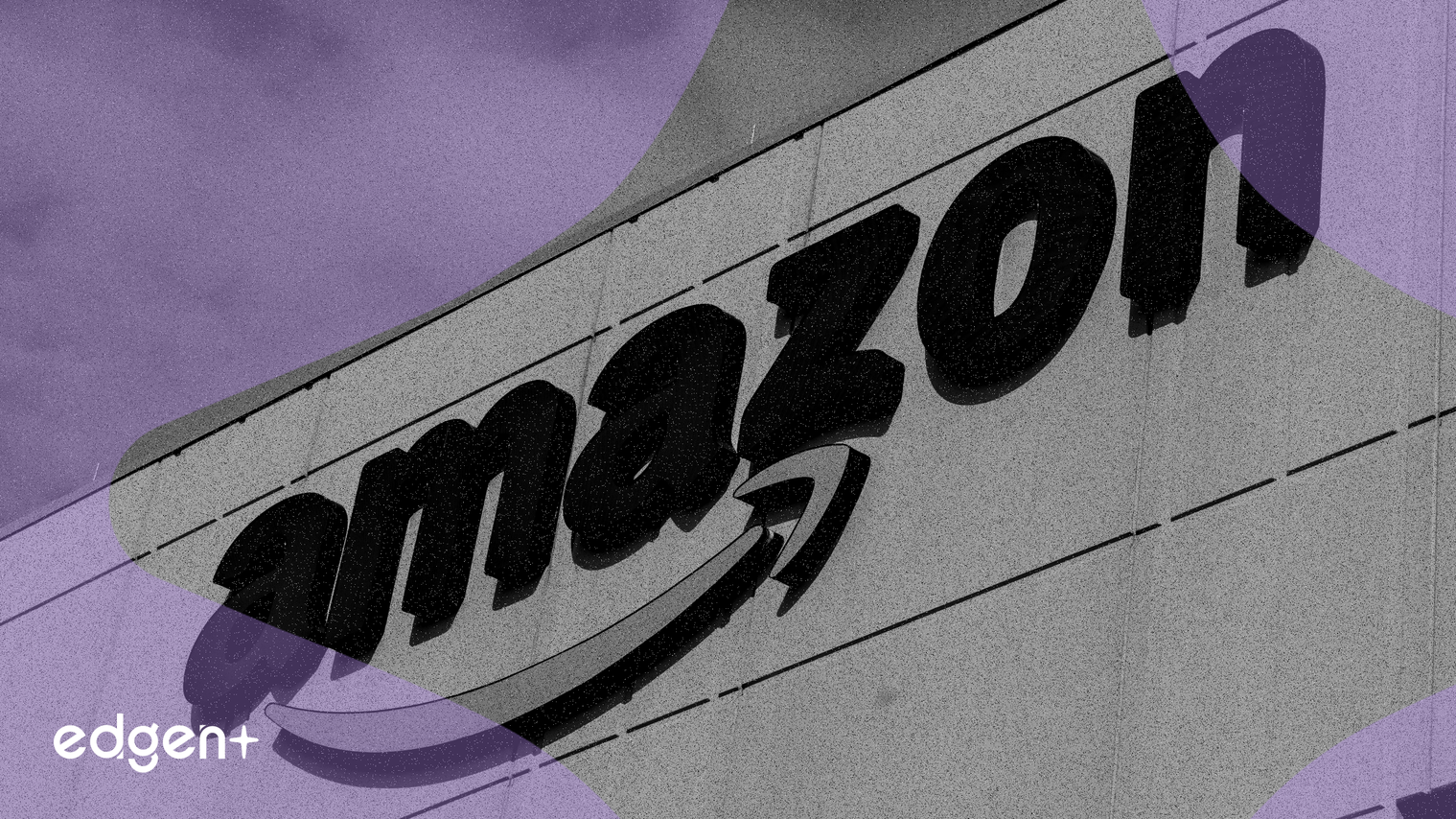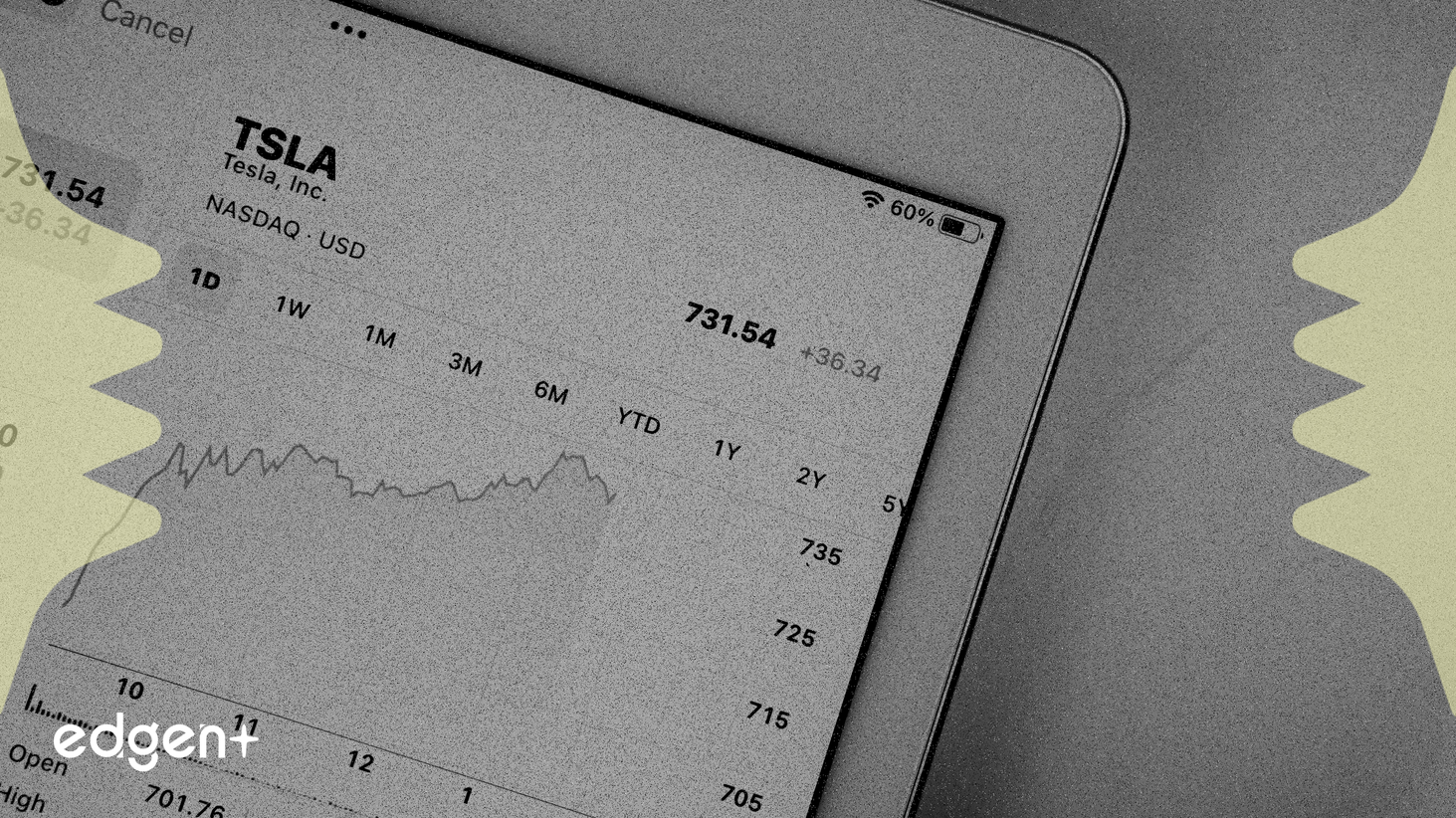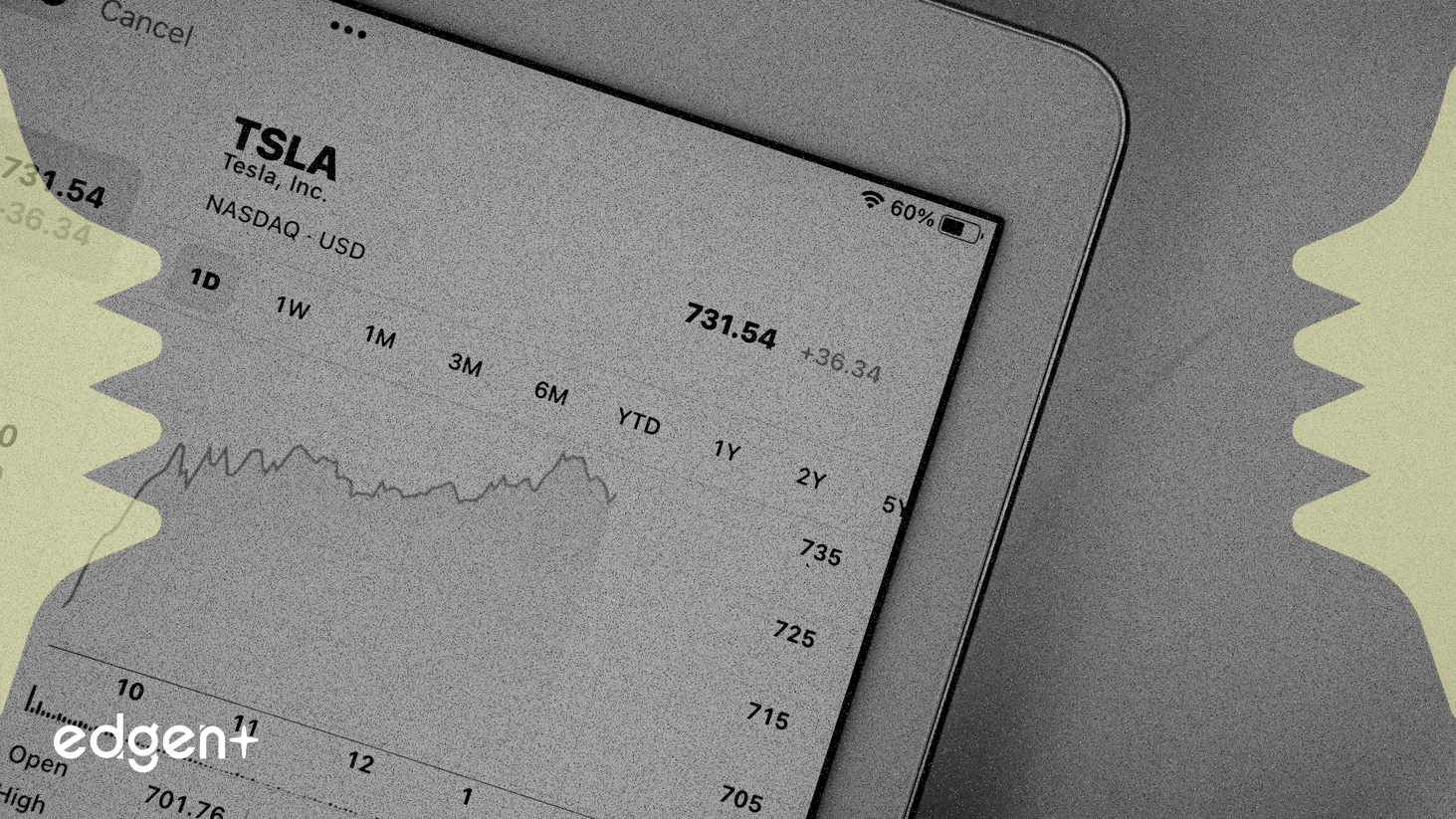Features
Trading Strategies
Resources
Ask AI About META

No Data Yet

## テクノロジーセクター、第3四半期に堅調な決算を発表 テクノロジーセクターは第3四半期に顕著な財務力を示し、主要企業である **Amazon.com Inc. (AMZN)** と **Apple Inc. (AAPL)** はアナリストの予想を上回る決算を報告しました。これらの結果は、市場全体のセンチメントを大幅に押し上げ、主要テクノロジー企業の回復力と成長見通しに対する投資家の信頼を強化しました。 ## アマゾンの業績はクラウドの強さに牽引され予想を上回る **アマゾン** は第3四半期に特に堅調な業績を上げ、ウォール街の予想を大幅に上回りました。このEコマースおよびクラウドコンピューティングの巨人は、**1802億ドルの売上高**を報告し、**前年比13%の増加**を記録しました。この数字は、アナリストのコンセンサス予想である1777億ドルを楽に上回りました。1株当たり利益(EPS)は**1.95ドル**に達し、前年同期の1.43ドルから大幅に増加し、予測された1.56ドルをはるかに上回りました。四半期の純利益は**212億ドル**で、昨年報告された153億ドルから増加しました。 アマゾンの堅調な業績の主要な推進要因は、クラウドコンピューティング部門である **Amazon Web Services (AWS)** の再加速でした。AWSは**330億ドルの売上高**を報告し、**前年比20%の成長**を記録し、アナリストの予想を上回りました。このセグメントだけで**114億ドル**の営業利益を計上し、アマゾンの総営業利益の半分以上を占めました。同社はまた、**2025年までに1000億ドル以上**を投資する計画を示しており、将来の拡大と技術的進歩に対する自信を示しています。アップルに関する具体的な数字は利用可能な資料では詳述されていませんが、中心的な分析によると、iPhoneメーカーも予想を上回る決算を発表し、より広範な好意的なセンチメントに貢献しました。 ## 市場、テクノロジーセクターの堅調な決算に好反応 これらの堅調な決算報告に対する市場の反応は特に好意的であり、投資家間の根底にある強気なセンチメントを反映しています。発表後、**アマゾン**株は時間外取引で**11%以上**急騰しました。この significant な動きは、会社の財務軌道、特に非常に収益性の高いAWS部門の新たな成長モメンタムに対する投資家の楽観論を強調しています。より広範な市場の先行指標と見なされるこれらの著名なテクノロジー企業の堅調な業績は、経済の逆風と金利圧力に関する懸念の一部を軽減するのに役立ちました。 **AWS** の成長の再加速は、クラウドサービスに対する企業の回復力のある需要の重要な指標と見なされており、企業がデジタル変革とインフラ投資を優先し続けていることを示唆しています。 ## 広範な影響と展望 **アマゾン** と **アップル** の堅調な決算は、市場、特にテクノロジーセクターとその全体的な株式パフォーマンスへの影響に関して、より広範な影響を及ぼします。 **AWS** が示したように、クラウドコンピューティングの堅調な成長は、デジタルインフラに対する持続的な需要を示しており、これはテクノロジーエコシステムにおける他のプレーヤーにとっても良い兆候です。業界リーダーからのこのようなパフォーマンスは、関連セクターへの信頼を強化し、成長志向の株式へのさらなる投資を誘致するポジティブな波及効果をしばしば生み出します。 **アマゾン** のような企業が大規模な設備投資を約束することは、長期的な戦略的ビジョンと継続的な拡大への期待を示唆しており、これは将来の成長シナリオを裏付ける可能性があります。 今後、市場参加者は、セクター全体の強さの裏付けとなる証拠を得るために、他のテクノロジー企業の今後の決算報告を注意深く監視するでしょう。さらに、マクロ経済指標、特に企業支出と消費者需要に関連する指標は、このポジティブな勢いの持続可能性を評価する上で重要となります。インフレの軌道と中央銀行の金融政策決定も、今後の投資家心理と市場の方向性に影響を与える主要な要因であり続けるでしょう。

## アルトリア、無煙たばこ製品への移行に伴い2025年第3四半期は好不調混在の業績 **アルトリア・グループ (Altria Group, Inc., MO)** は、2025年第3四半期の財務結果を発表しました。同社は、困難な従来のたばこ市場を乗り切りつつ、無煙代替品の成長を積極的に追求しているため、業績は好不調が混在していました。同社の調整後希薄化1株当たり利益 (EPS) は、営業効率と戦略的な資本配分を反映して3.6%増加し、**1.45ドル**となりました。しかし、純収益は前年同期比で3.0%減少し、**61億ドル**にとどまりました。 ## 財務ハイライトと戦略的資本展開 2025年第3四半期、**アルトリア** の純収益は **61億ドル** で、前年比3.0%減少しました。消費税控除後の収益は1.7%減少し、**53億ドル** となりました。収益減少にもかかわらず、調整後希薄化EPSは3.6%増の **1.45ドル** に増加しました。報告された希薄化EPSは5.2%増の **1.41ドル** でした。 株主還元への同社のコミットメントは、**自社株買いプログラム** の拡大を通じて明らかになりました。取締役会は、プログラムを **10億ドルから20億ドル** に増額し、2026年12月31日まで延長することを承認しました。2025年第3四半期だけで、**アルトリア** は平均価格 **60.13ドル** で **190万株** を買い戻し、総額 **1億1200万ドル** に達しました。2025年9月までの年初来では、平均価格 **58.08ドル** で **1230万株** が買い戻され、総額 **7億1200万ドル** になりました。 株主価値への注力をさらに強調するため、**アルトリア** は通常の四半期配当を3.9%増の **1株あたり1.06ドル** に引き上げ、これは56年間で60回目の配当増額となります。これは年間 **4.24ドル** の配当に相当します。 ## 製品ポートフォリオの移行と規制の進展 第3四半期は、**アルトリア** の従来の喫煙製品セグメントへの継続的な圧力を明らかにしました。国内たばこ販売量は、2025年第3四半期に8.2%減少し、2024年9月30日に終了した最初の9か月で10.6%減少しました。これは、当四半期の業界推定減少率8%とは対照的です。全体的な販売量減少にもかかわらず、**マールボロ (Marlboro)** のプレミアムセグメントにおけるシェアは前年比0.3ポイント増の **59.6%** となり、**PM USA** のたばこ小売総シェアは前期比0.3ポイント増の **45.4%** となりました。 口腔たばこセグメントでは、**ON!** ブランドが回復力を示し、2025年第3四半期の出荷量は約1%増加しました。米国のニコチンパウチカテゴリーは著しく成長し、現在、米国の口腔たばこカテゴリーの **49.1%** を占め、前年比で8.7シェアポイント増加しました。 **アルトリア** の電子たばこセグメントは、**NJOY ACE** に影響を与えるITC命令により、2025年第1四半期に電子たばこ報告単位に関連する非現金 **8億7300万ドル** ののれん減損を計上するなど、課題に直面しました。**NJOY** の出荷量は70%減の30万ユニットとなり、CEOのビリー・ギフォードは、FDAが認可したフレーバーの選択肢がないため、違法市場が大きな影響を与えていると指摘しました。 無煙たばこセクターにとって重要な進展は、経口ニコチンパウチの市販前たばこ製品申請 (PMTA) の審査プロセスを合理化するための **FDAのパイロットプログラム** です。9月に開始されたこのイニシアチブは、いくつかの分野で製品固有の研究の必要性をなくすことで、メーカーの要件を緩和することを目指しており、**アルトリアのON! Plus** などの製品の市場アクセスを潜在的に加速させる可能性があります。 ## 戦略的パートナーシップと将来の成長経路 **アルトリア** は、グローバルな無煙および非ニコチン製品ポートフォリオを拡大するために戦略的パートナーシップを積極的に追求しています。同社は、韓国のたばこおよび高麗人参会社である **KT&G** と、グローバルなニコチンパウチ製品の成長を共同で追求し、米国における非ニコチン製品を探索するための契約を締結しました。最初のステップとして、**アルトリア** の子会社は、**LOOPニコチンパウチ** ブランドの製造元である **アナザー・スヌース・ファクトリー (ASF)** の所有権を取得し、同時に **KT&G** が同社を買収します。この協力は、長期的な成長のために補完的な市場経験と能力を活用することを目的としています。 ニコチンを超えた成長の追求も進行中であり、**アルトリア** の子会社と **KT&G** の子会社である **韓国人参公社 (KGC)** は、米国ウェルネス分野での機会を共同で探索しています。 ## 見通しと投資家の考察 今後の見通しとして、**アルトリア** は2025年通期の調整後EPSガイダンスを **5.37ドル~5.45ドル** の範囲に縮小しました。これは2024年の基準 **5.19ドル** から3.5%~5.0%の成長を意味します。経営陣は、これまでの株式削減を補い、ダイナミックな規制環境の中で無煙たばこ戦略への投資を継続するため、第4四半期の業績は穏やかになると予想しています。 成人喫煙者をリスク低減代替品に移行させるという同社の重点、戦略的投資、パートナーシップと相まって、**アルトリア** は変化する消費者嗜好と規制環境に適応できる立場にあります。拡大された自社株買いプログラムと一貫した配当増加は、株主へのリターンを引き続き支援すると予想されます。投資家は、**FDA** の合理化された審査プロセスがニコチンパウチ製品の成長軌道に与える影響と、**アルトリア** の国際拡大戦略の有効性を綿密に監視するでしょう。

## 主要企業の決算と金融政策への期待が市場情勢を形成 米国株式市場は現在、記録的な高水準で推移しており、投資家の注目は重要な出来事の confluence に集中しています。来週は、「華麗なる7社」と称される大手テクノロジー企業の決算報告と、連邦準備制度理事会による金利調整への広範な期待が中心となります。同時に、国際貿易関係の進展は一様ではありません。 ## 高まる期待の中でテクノロジー大手が決算を発表 今週は、主要テクノロジー企業から重要な第3四半期決算報告が発表される予定です。**Alphabet-A (GOOGL.US)** は10月29日の市場取引終了後に決算を発表する予定です。コンセンサス予想では、第3四半期の1株あたり利益(EPS)は8%増の**2.28ドル**、収益は13%増の**999億ドル**に達すると見られています。堅調な業績を達成すれば、同社の収益は初めて**1000億ドル**を突破する可能性があります。 **Microsoft (MSFT.US)** は、水曜日の市場取引終了後に第1四半期決算を発表します。FactSetのコンセンサス予測では、EPSは11%増の**3.66ドル**、収益は15%増の**754億ドル**になると見られています。アナリストが注目する主要な分野は、Azureクラウドコンピューティングサービスの成長とCopilot AI製品の進展であり、Azureの収益は前年比**38%**の成長が見込まれています。12月期(会計年度第2四半期)については、アナリストはEPSが18%増、収益が15%増の**800億ドル**に達すると予測しています。 **Meta Platforms (META.US)** は、水曜日遅くに第3四半期決算を発表する予定です。EPSは11%増の**6.69ドル**、収益は22%増の**494億ドル**になると予想されています。アナリストは、FacebookとInstagramプラットフォーム全体における広告収益の継続的な好調さや、人工知能への投資イニシアチブに関する最新情報を注視するでしょう。 **Apple (AAPL.US)** は、木曜日遅くに会計年度第4四半期決算を発表する予定です。ウォール街のアナリストは、EPSが前年比8%増の**1.77ドル**、収益が7.5%増の**1020億ドル**になると予想しています。この報告期間には、新しいiPhone 17シリーズの初期販売実績が含まれます。12月期(会計年度第1四半期)については、EPSが5.5%増の**2.53ドル**、収益が約6%増の**1314億ドル**になると予測されています。 最後に、**Amazon (AMZN.US)** は木曜日遅くに決算を発表します。アナリストは、第3四半期のEPSが10%増の**1.57ドル**、収益が12%増の**1778億5000万ドル**に達すると予測しています。 ## 連邦準備制度、金利調整の準備 重要なマクロ経済の動向は、連邦準備制度理事会(Fed)の金融政策に関わるものです。安定したインフレと労働市場への継続的な下方リスクを背景に、中央銀行は10月28日から29日の会合で利下げを実施すると広く予想されています。10月25日現在、CMEグループのFedWatchデータは、連邦公開市場委員会(FOMC)がフェデラルファンド金利を**25ベーシスポイント(0.25%)**引き下げる可能性が**98.3%**であることを示しています。この調整により、新しい範囲は**3.75%から4.0%**となり、2022年後半以来の最低水準となります。この予想される動きは、市場議論の中心となり、借入コストと投資家心理に影響を与えるでしょう。 ## 進化する国際貿易の力学 国際貿易の状況は二重の物語を提示しています。米国と中国間の貿易協議では進展が見られ、これは世界最大の2大経済国間の緊張緩和の可能性を示唆しています。対照的に、米国とカナダ間の関税摩擦は激化しています。ドナルド・トランプ米大統領は、既存の税率に加え、カナダからの輸入品に**追加で10%の関税引き上げ**を示唆しました。この発表は、カナダのオンタリオ州が放映した広告に続くもので、新しい関税は現在の**35%の基本税率**に上乗せして適用されます。米国・メキシコ・カナダ協定(USMCA)の下でカバーされる商品は、現在これらの追加関税から免除されています。 ## 企業活動:ノバルティス、Avidity Biosciences買収によりパイプラインを強化 重要な企業ニュースとして、**ノバルティス(Novartis、NVS)**は2025年10月26日、**Avidity Biosciences, Inc.(RNA)**を1株あたり**72.00ドル**の現金で買収する契約を発表しました。これは、2025年10月24日のAvidityの終値に対して**46%のプレミアム**に相当します。この取引により、完全に希薄化後のAvidityの評価額は約**120億ドル**、企業価値は約**110億ドル**となります。慣習的なクロージング条件と規制当局の承認を条件として、この買収は2026年前半に完了する見込みです。この戦略的動きにより、ノバルティスの2024年から2029年の年間売上成長率(CAGR)は**+5%から+6%**に増加し、特に後期神経科学パイプラインを強化することが期待されます。合併完了に先立ち、Avidityは初期段階の精密心臓病プログラムを全額出資子会社であるSpinCoに移管する予定です。 ## 市場への影響と今後の見通し これらの出来事の収束は、金融市場にとって複雑な短期的な見通しを生み出しています。テクノロジーセクターからの堅調な決算報告は、特に企業がアナリストの予想を上回り、AI統合に関して楽観的な先行きのガイダンスを提供すれば、継続的な上昇モメンタムをもたらす可能性があります。予想される連邦準備制度による利下げは、確認されれば市場にはほぼ織り込み済みですが、緩和的な金融政策スタンスを示すことで投資家の信頼をさらに強化する可能性があります。逆に、特にカナダのような主要な隣国との貿易摩擦のエスカレートは、不確実性要素と特定のセクターにとって潜在的な逆風をもたらします。投資家は、企業ガイダンス、連邦準備制度理事会が提供する正確な文言と将来の見通し、および国際貿易交渉におけるさらなる進展を注意深く監視するでしょう。これらの要因は、今後数週間で市場の方向性を形作る準備が整っているからです。

## 多様な市場の動きが取引セッションを特徴付ける 米国の株式市場は、商品市場における大きな変化、企業の戦略的調整、および個々の企業業績が投資家心理に影響を与え、まちまちの動きを見せました。貴金属は大幅な下落を経験した一方、**Beyond Meat** (BYND) のような個別株は極端なボラティリティを示しました。**Meta Platforms** (META) はAI部門の戦略的再編を発表し、**AT&T** (T) は堅調な加入者数の伸びを報告し、**Texas Instruments** (TXN) は今後の四半期について慎重な見通しを示しました。 ## 主要イベントが市場の変化を詳細に説明 取引セッションは、さまざまなセクターにおけるいくつかの明確な展開によって特徴付けられました。 **貴金属に圧力:** **金** (XAUUSD:CUR) は、史上最高値の4,381ドルから1オンスあたり4,082ドルへと約6.3%の著しい下落を経験し、2013年以来最大の1日での下落となりました。同時に、**銀** (XAGUSD:CUR) は約7.5%急落し、1オンスあたり47.12ドルに達し、最近の高値から10%以上下落して調整局面に入りました。この歴史的な1日での急落は2025年10月21日に発生しました。 **Beyond Meat (BYND) ショートスクイーズ:** **Beyond Meat** (BYND) の株価は、前セッションでの約150%の上昇に続き、本日50%以上急騰しました。この劇的な上昇は、大規模なショートスクイーズと、新たな「ミーム株」活動に起因すると考えられます。 **Meta Platforms (META) AI再編:** **Meta Platforms** (META) は、AI部門内で、特にSuperintelligence Labsに影響を与える約600の職務の削減を確認しました。この戦略的な動きは、AIインフラ、研究、製品チームの従業員に影響を与えます。この人員削減は、**Scale AI**への143億ドルの投資、および**Hyperion**データセンター向けの**Blue Owl Capital**との270億ドルのパートナーシップを含む、多額の投資の後に実施されました。 **AT&T (T) 加入者予想を上回る:** **AT&T** (T) は2025年第3四半期に堅調な業績を報告し、継続的な顧客需要を示しました。同社は28万8000人の**AT&T Fiber**純加入者と40万5000人のワイヤレス後払い電話純加入者を獲得しました。四半期の収益は307億ドルに達し、前年比で1.6%増加し、調整後希薄化後1株当たり利益 (EPS) は0.54ドルでした。フリーキャッシュフローは前年比46億ドルから49億ドルに増加しました。 **Texas Instruments (TXN) 慎重な見通しを発表:** **Texas Instruments** (TXN) の株価は、同社が混合的な第3四半期決算と予想を下回る第4四半期見通しを発表した後、市販前取引で約8%下落しました。第3四半期のEPSは1.48ドルで、コンセンサスの1.49ドルをわずかに下回りましたが、売上高は前年比で14%増加しました。第4四半期のガイダンスでは、売上高が42.2億ドルから45.8億ドル、EPSが1.13ドルから1.39ドルの間と予想されており、いずれもアナリスト予想の45億ドルと1.39ドルを下回っています。 ## 市場反応分析と根本的な推進要因 **貴金属:** **金**と**銀**の急激な下落は、主に複数の要因の複合的な影響によって引き起こされました。これには、ドル高が含まれ、これによりドル建ての商品は国際的な買い手にとって高価になります。地政学的緊張の緩和、特に米中貿易交渉に関する楽観論は、伝統的な安全資産としてのこれらの金属に対する需要を減少させました。この変化は、投資家が資本をよりリスクの高い資産に再配分することを促しました。さらに、長期にわたる上昇後の大幅な利益確定と、「買われすぎ」状態を示すテクニカル指標が売り圧力を強めました。 **Beyond Meat:** **Beyond Meat**の株価の劇的な動きは、主に大規模なショートスクイーズに起因しています。これは、価格の急速な上昇が空売り投資家に損失を限定するために株式を買い戻すことを強制する現象です。これに「ミーム株」のダイナミクスに影響された個人投資家の新たな関心が加わり、企業のファンダメンタルズとは大きく関係なく急騰を煽りました。 **Meta Platforms:** **Meta**のAI部門における人員削減は、CEOの**マーク・ザッカーバーグ**が運営の俊敏性を高め、官僚主義を削減するための戦略的イニシアチブの一部です。この合理化は、競争の激しい人工知能分野における**Meta**のペースを加速することを目的としています。この動きは、**Meta**がAIインフラへの投資を大幅に増加させた後に行われ、高度なAIシステムにおけるリーダーシップを確立するための長期的な戦略的転換を示唆しています。世界のAI市場は2025年までに7,575億8千万ドルに達し、継続的な急速な拡大が予想されます。 **AT&T:** 市場は、**AT&T**の堅調な加入者増加と戦略的ポジショニングに対し、慎重ながらも楽観的に反応しました。投資家は、売上高とEPSの予測がわずかに下回ったことよりも、高価値のワイヤレスおよび光ファイバー顧客の獲得における同社の成功と「差別化された投資主導型戦略」を優先しているようでした。**AT&T Fiber**およびワイヤレス後払い電話の純増数の持続的な増加は、その「コンバージェンス戦略」の有効性を裏付けています。 **Texas Instruments:** **Texas Instruments**の第4四半期の収益見通しが弱かったことは、一部のマージン圧力は予想されていたものの、多くのアナリストを驚かせました。在庫の積み上がりを管理するために稼働率を下げるという同社の決定は、慎重な運営調整ではありますが、粗利益にさらなる圧力をかけると予想されます。これは、半導体市場の特定のセグメントにとって、以前の予測よりも長引く景気循環的低迷を示します。 ## 広範な背景と業界への影響 **金**と**銀**の著しい下落は、投資家心理のより広範な変化を示す可能性があり、世界の経済安定性の向上と地政学的リスクの減少という認識の中で、伝統的な安全資産から遠ざかる動きを示唆する可能性があります。このリスク選好度の再評価は、市場全体の資産配分に広範な影響を与える可能性があります。 **Beyond Meat**の最近の急騰は、ソーシャルメディア主導の個人投資家取引とショートスクイーズの継続的な影響を浮き彫りにしています。これは、多くの場合、基礎となる財務指標とは切り離された特定の株式において極端なボラティリティを生み出す可能性があります。この現象は、感情に左右されやすい市場セグメントをナビゲートする機関投資家にとっての継続的な課題を強調しています。 **Meta Platforms**のAI部門における再編は、**OpenAI**や**Google**のような企業も積極的な投資を行っている**AIセクター**におけるテクノロジー大手間の激しい競争を浮き彫りにしています。**Meta**が2025年と2026年のAIイニシアチブに対する支出ガイダンスを引き上げたことは、その競争上の地位を大幅に再定義し、より広範なWeb3エコシステムに影響を与える可能性のある、深遠な長期戦略的コミットメントを示唆しています。世界のAI市場は2025年までに7,575億8千万ドルに達し、継続的な急速な拡大が予想されます。 **AT&T**のワイヤレスおよび光ファイバー加入者増加における堅調な実績は、現代の市場環境における堅牢な接続サービスの極めて重要な重要性を再確認しています。同社の戦略的買収と継続的な光ファイバー拡張計画は、競争の激しい通信業界において持続的な成長を可能にする位置付けにあります。同社の現在のバリュエーション指標は、株価収益率 (P/E) 14.61、株価売上高倍率 (P/S) 1.49、株価純資産倍率 (P/B) 1.75です。 半導体分野の主要な先行指標である**Texas Instruments**の慎重な見通しは、**半導体産業**、特にアナロググループにとって、より広範な逆風を示す可能性があります。**Morgan Stanley**のアナリスト、**Joseph Moore**は、「来年第2四半期まで景気循環的な回復が見られないため、現在アナロググループを支持しない」と指摘しました。このセンチメントは、**Intel** (INTC)、**Micron Technology** (MU)、**NVIDIA**などの他の主要な半導体プレーヤーにも影響を与え、セクターの景気循環的回復が遅れる可能性を示唆します。 ## 専門家のコメント **Texas Instruments**に関して、**Jefferies**は「ホールド」のレーティングを維持しつつ、目標株価を185ドルから180ドルに引き下げ、「このガイダンスは、アナロググループの景気循環的な上昇が一時停止しているように見えるため、より通常の季節的な減少を反映している」と述べました。同様に、**Morgan Stanley**は「アンダーウェイト」のレーティングを維持し、目標株価を192ドルから175ドルに引き下げ、アナリストは「ある程度のマージン圧力は予想していたものの、売上高の見通しが弱かったことは驚きだった」と強調しました。彼らはさらに、「来年第2四半期まで景気循環的な回復が見られないため、現在アナロググループを支持せず、TXNについては傍観を続ける」と付け加えました。 **Meta**のAI再編に関して、「業界アナリストは、この人員削減を、重複を排除し、競争の激しいAIレースにおけるMetaのペースを加速するための戦略的努力と見ている」と述べています。これは、人員削減にもかかわらず、この動きが計算された戦略的転換であるというコンセンサスを示唆しています。 ## 今後の展望 **金**と**銀**の価格の将来の軌道は、今後のマクロ経済データ、特にインフレ報告書と連邦準備制度理事会の金融政策に関するあらゆるシグナルの影響を大きく受けるでしょう。地政学的安定性の変化も、安全資産需要にとって引き続き重要な要素となるでしょう。 **Beyond Meat**を取り巻くボラティリティは、ミーム株のラリーの持続可能性を測るバロメーターとして機能し続け、投機的な関心が基礎となるファンダメンタルパフォーマンスにどれだけ長く逆らえるかを試すでしょう。投資家は、この熱意が持続可能な長期的な価値に変換できるかどうかを注意深く見守るでしょう。 **Meta**のAIへの積極的な投資と進行中の再編の取り組みは、運用効率と、同社が野心的なAI目標を達成する能力への影響について綿密に監視されるでしょう。高額な設備投資を持続可能で収益性の高い成長に転換することが課題となるでしょう。 **AT&T**の光ファイバー拡張とコンバージェンス戦略の継続的な実行は、競争の激しい通信業界において、加入者の勢いを維持し、財務目標を達成するために極めて重要となるでしょう。 **Texas Instruments**の慎重なガイダンスの後も、**半導体セクター**は引き続き綿密な調査を受けるでしょう。投資家は、アナログセグメントおよびより広範な産業用途における需要トレンドに特に注意を払いながら、今後数四半期における景気循環的回復の明確な兆候を探すでしょう。

## 需要の加速がエネルギー情勢を再構築 人工知能(AI)データセンターからの需要の急増が国の電力網に前例のない負担をかけているため、米国株式市場では、特に**公益事業部門**および重要なエネルギーインフラを供給する企業の間で顕著な変化が見られます。主に**ビッグテック**の事業の急速な拡大によって引き起こされるこの電力需要の増加は、公益事業会社に大規模なインフラ投資を促し、同時に規制対応を推進し、消費者の電気料金に影響を与えています。 ### AIエネルギーの必然性 この市場の動きの中心にあるのは、**AIデータセンター**による電力消費の大幅な増加です。**ゴールドマン・サックス**の推定によると、米国全土でのAIブームを維持するには、約**50ギガワット**の新しい電力容量(4,000万世帯に電力を供給するのに相当)が必要になるとのことです。これは、過去10年間に観測されたほぼ横ばいの電力需要からの顕著な変化を示しています。これらのエネルギー要件の途方もない規模は、バージニア州の**ドミニオン・エナジー**に対する2ギガワットの電力提案のようなシナリオによって例示されており、これは2基の原子炉に匹敵する負荷です。 **アマゾン** (AMZN)、**マイクロソフト** (MSFT)、**グーグル** (GOOG) を含む主要なテクノロジー企業は、この需要急増の最前線に立っています。これらの企業が拡大するAI運用に電力を供給しようとしている一方で、電力需要を発電および送電容量に変換するプロセスには数年かかります。将来の需要予測を取り巻く不確実性や供給過剰の可能性は、公益事業会社にとって重大な懸念事項です。例えば、**マイクロソフト**は、合計2ギガワットの負荷を持つ米国およびヨーロッパの提案されたデータセンタープロジェクトを断念したと報じられていますが、これは**TDカウエン**のアナリストによって、AIコンピューティング技術の潜在的な供給過剰に起因するとされています。インフラ投資が実際の需要を上回った場合、このようなキャンセルは公益事業会社に「座礁資産」と多額の回収不能なコストを残す可能性があります。 ### 規制の監視と財務への影響 この需要を満たすために必要な多額のインフラ投資は、消費者コストに直接影響を与え、規制当局の高い関心を集めています。全米の電力会社は、主にこれらのグリッドアップグレードに資金を供給するために、2025年上半期に**290億ドル**の消費者料金値上げを追求しており、これは昨年同期から142%の増加です。第3四半期には、電気とガスの平均公共料金支払額が前年比で3.6%増加しました。これは、AIの構築の加速に関連する傾向です。 規制当局はこれらの圧力に対応しています。**PJMインターコネクション**の市場監視機関である**モニタリング・アナリティクス**は、**連邦エネルギー規制委員会(FERC)**に対し、**PECOエナジー**(**エクセロン**傘下の公益事業会社、EXC)と**アマゾン・データ・サービス**間の送電サービス契約を却下するよう促しました。この介入は、この契約が小売電力顧客のエネルギーおよび容量コストを増加させ、グリッドの信頼性に悪影響を与える可能性に関する懸念を浮き彫りにしています。FERCの審査結果は、米国全土で大規模な負荷の顧客がどのように管理されるかについて前例となる可能性があります。 オハイオ州では、**オハイオ州公共事業委員会(PUCO)**が、**AEPオハイオ** (AEP) が提案したデータセンターに対する強化された財政的義務を課す計画を承認しました。これには、新規データセンター顧客が12年間で契約電力の少なくとも85%を支払うこと、および契約解除時の潜在的な解約金が含まれます。この措置は、コストが住宅および小規模商業顧客に転嫁されるのを防ぎ、テクノロジーセクター内での規律ある成長を確保することを目的としています。同時に、**エネルギー省(DOE)**は、データセンター、AI、製造開発によって引き起こされる世代的な負荷増加を認識し、送電ケーブルの再建のために**AEP**に**16億ドルの融資**を承認しました。 ### 市場パフォーマンスと広範な状況 金融市場はこれらの動きを反映しています。**ユーティリティズ・セレクト・セクターSPDRファンド** (XLU)、**バンガード・ユーティリティーズETF** (VPU)、**iシェアーズ米国ユーティリティーズETF** (IDU) は、年初来でそれぞれ7.32%、7.63%、8.23%の利益を示しており、消費者のコスト上昇にもかかわらず、これらのトレンドを活用するセクターの能力に対する投資家の信頼を示しています。 電力セクターの機器メーカーもまた、追い風を経験しています。**ゼネラル・エレクトリック**から最近スピンオフした**GEベルノバ** (GEV) は、今年株価が80%以上上昇し、目覚ましい業績を上げています。アナリストは、電化および脱炭素化インフラに対する需要の急増の中での戦略的な位置付けを理由に、**GEベルノバ**に対して強気の見方を示しています。この業績は、グリッドのアップグレードと発電設備に対する高まるニーズの直接的な受益者を強調しています。 より広範な文脈は、技術の進歩を可能にすることと、公平なコスト配分とグリッドの安定性を確保することとの間の微妙なバランスを示唆しています。公益事業会社はジレンマに直面しています。インフラを過剰に構築すれば財政的損失のリスクがあり、不十分に構築すれば停電や罰金のリスクがあります。この不確実性により、一部の公益事業会社は契約が確保されるまでアップグレードを延期したり、よりモジュール性と適応性を高めるためにシステムを再設計したりしています。 ### 専門家のコメント > '多くの[グリッド接続要求]は、複数の公益事業サービス地域でデータセンターを提案している開発者からのもののようです。彼らは「どこに最も速く接続できるか?どこで取引ができるか?」を探しています'と、調査会社**エナジーイノベーション**の電力モデリングディレクターである**ブレンダン・ピアポン**は述べ、一部のデータセンター提案の投機的な性質を強調しました。ピアポン氏はまた、長期的なビジネスモデルと実際の計算要件に関する「膨大な不確実性」についても警告しました。 **TDカウエン**のアナリストは、**マイクロソフト**がデータセンター計画を縮小した決定は、新しいAIモデルにおけるチップと冷却効率の向上に一部起因している可能性があり、これにより計算ごとの電力需要が削減される可能性があると指摘しました。これは、AIの電力需要の将来の軌道が線形ではない可能性を示唆しており、公益事業の計画にさらなる複雑さを加えています。 ### 今後の展望 急速に拡大する**AIインフラ**、**公益事業の投資サイクル**、そして**規制の枠組み**の相互作用は、今後数四半期において引き続き重要な市場要因となるでしょう。注目すべき主要な分野には、FERCおよび州の公共事業委員会からのさらなる規制決定、特にコスト配分とグリッドの信頼性に関するものが含まれます。主要なテクノロジー企業が電力需要を正確に予測し、それにコミットする能力は、公益事業会社の財政健全性と電力網の安定性に大きく影響します。さらに、AI効率と冷却システムの技術的進歩は、将来のエネルギー需要の増加を緩和し、長期的な投資戦略を改

## XOVRのクロスオーバー戦略の紹介 米国の株式市場は、これまで一部の投資家しかアクセスできなかった資産クラスへのアクセスを民主化するために設計された新しい投資手段の出現により、大きな変化を遂げています。**ERSharesプライベート・パブリック・クロスオーバーETF(XOVR)**は、この傾向を象徴しており、**2024年8月30日**に再開され、個人投資家が新規株式公開(IPO)前の段階にある企業にエクスポージャーを得られる初のETFとなりました。この発展は、ベンチャーキャピタリスト、機関投資家、インサイダーに伝統的に限定されてきた重要な瞬間を示し、企業が公開市場に上場する前にしばしば発生する富の創造に一般投資家が参加できるようにすることを目指しています。 ## 詳細なイベント:新しい投資パラダイム **XOVR**の戦略的な再開には、独自の**アントレプレナー30トータルリターンインデックス(ER30TR)**と選択的なプライベート・エクイティへのエクスポージャーの組み合わせが含まれていました。このハイブリッド構造は、公開市場とプライベート市場の両方で成長機会を捉えるように設計されています。このアプローチの重要な例は、Klarnaが**2025年9月10日**にIPOを行う前に、**XOVR**が**Klarna**の株式を組み入れたことでした。Klarnaの株式はIPO価格40ドルを上回る52ドルで取引を開始し、13.7億ドルを調達し、2021年のピークから評価額が下落したにもかかわらず、同社の評価額は200億ドル近くに達しました。 このETFは、資産の大部分(85%以上)を、30の大型起業家米国株式で構成される**ER30TRインデックス**に投資するように構成されています。残りの部分(最大15%)は、戦略的にプライベート・エクイティ証券に割り当てられます。現在の保有銘柄は、**NVIDIA Corp.(10.08%)**、**AppLovin Corp.(5.86%)**、**Meta Platforms Inc.(5.83%)**、**Oracle Corp.(4.18%)**などの確立された公開イノベーターと、**SpaceX(SPVエクスポージャー経由で6.95%)**、**Anduril**、**Klarna(Fika Holdings SPV QP LPが発行する私募証券経由)**などの注目すべき非公開企業を組み合わせています。これらの配分は、多岐にわたるセクターにおける初期段階の成長に対するファンドのコミットメントを強調しています。 ## 市場の反応とパフォーマンス分析 **XOVR**の革新的な構造とパフォーマンスに対する市場の反応は注目に値しました。**2024年8月30日**の再開から**2025年9月30日**まで、このETFは合計で**+37.2%(配当再投資後)**のリターンをもたらしました。このパフォーマンスは、同じ期間に主要なベンチマーク指数を大幅に上回りました。 * **S&P 500**:+20.1% * **Russell 1000 Growth**:+28.9% * **Nasdaq 100**:+26.9% * **Dow Jones Industrial Average**:+13.7% この実質的なアウトパフォーマンスは、個人投資家が規制され、流動性のあるプライベート市場の成長へのアクセスに対して強い意欲を持っていることを示唆しています。**XOVR**がIPO前の企業を公開取引ETFの枠組みに統合する能力は、企業がより長期間非公開のままでいる傾向に対処する重要な革新であり、これにより富の創造の大部分がより初期の、アクセスしにくい段階に移行しています。 ## 広範な背景と影響 **XOVR**の成功は、投資環境を大きく再形成する可能性があります。これは、高成長の非公開企業へのエクスポージャーに対する個人投資家の間で高まる需要を示唆しており、資本配分傾向に影響を与え、プライベート・パブリック・クロスオーバー分野に焦点を当てた金融商品のさらなる革新を促進する可能性があります。このモデルはまた、非公開企業が資本を調達し、公開市場に移行するための新しい道筋を提供し、従来のIPOプロセスとタイムラインを潜在的に変更する可能性があります。 **米国証券取引委員会(SEC)**による規制変更は、登録済みクローズドエンド型ファンドによるプライベートファンド投資に対する15%の上限の撤廃や、特定のファンドの適格性の拡大を含め、この拡大を促進しました。しかし、これらの発展は、システムリスクと投資家保護に関する重要な考慮事項ももたらします。 このようなハイブリッド構造における個人投資家にとっての潜在的なリスクは次のとおりです。 * **評価の不透明性**:プライベート・エクイティの評価は、公開市場の評価よりも複雑で不透明である可能性があり、純資産価値(NAV)の安定性を維持するために数字が膨らまされる可能性があります。 * **流動性のミスマッチ**:プライベート資産は本質的に流動性が低いです。**XOVR**は日々の流動性を目指していますが、流動性のあるETF構造内で非流動性資産を管理することは課題を提示し、早期の資産売却を強制する可能性があります。 * **階層化された手数料**:特に「ファンド・オブ・ファンズ」構造に投資する場合、このようなファンドの投資家は、複数層の管理手数料を負担する可能性があります。 * **透明性の欠如**:公開証券と比較して、プライベート資産に対する開示要件が厳しくないため、投資家が基礎となる保有資産や評価に関する可視性を制限する可能性があり、通常公開ファンドでは許可されていないレバレッジまたは関連取引を伴う可能性があります。 ## 専門家のコメント ERSharesのCOO兼最高投資戦略責任者である**Eva Ados**は、ファンドの使命を強調しました。 > 「個人投資家がついにIPOのテーブルに着く時が来ました。あまりにも長い間、このダイナミックな成長段階は機関投資家とインサイダーにのみ予約されていました。Klarnaを通じて、XOVRは、インサイダーが参加するのと同じ時点で一般投資家にエクスポージャーを提供することで、そのギャップを縮めることができることを示しました。」 ERSharesの創設者兼CIOである**Joel Shulman**は、**XOVR**の画期的な性質を強調しました。 > 「XOVRは単なる別のETFではありません。それは画期的なものです。私たちはER30TRインデックスを基盤として最先端の公開イノベーターを捉え、当社のプライベート・エクイティ配分は、個人投資家が歴史的に締め出されてきた機会へのアクセスを拡大するように設計されています。今日の富の創造の大部分は、市場のオープンベルが鳴る前に起こります。XOVRがその障壁を打ち破り、一般投資家がプライベートとパブリックの全サイクルを通じて、日々の流動性を持つ単一のETFで成長に参加できる扉を開くと信じています。」 ## 今後の展望 **XOVR**の成功と採用率は、個人投資家間のプライベート市場エクスポージャーに対する広範な需要を示す重要な指標となるでしょう。このETFが引き続き多額の資産を引き付け、一貫したパフォーマンスを示すならば、他の資産運用会社から同様の「クロスオーバー」ファンドが続出し、プライベート市場へのアクセスをさらに正常化する可能性があります。これにより、プライベート市場の特定のセグメントの流動性が高まり、非公開企業の評価額や資金調達戦略に影響を与える可能性があります。 ただし、投資家保護、非公開保有資産の評価方法、および市場全体の安定性に関する規制当局の監視は強化される可能性が高いです。業界は、これらのハイブリッド構造が日々の流動性を持つETFの枠組み内で、プライベート資産固有の非流動性と評価の複雑性をどのように管理し、アクセス可能性と一般投資家のための慎重さのバランスをどのように取るか、を注意深く見守るでしょう。

## Industry Alliance Seeks Enhanced Digital Ad Auction Transparency Major advertisers are collectively urging **Big Tech** companies, including **Alphabet**'s **Google** (**GOOGL**), **Meta Platforms** (**META**), and **Amazon.com** (**AMZN**), to adopt new transparency standards for digital ad auctions. This concerted effort arrives amidst a complex regulatory environment and ongoing antitrust legal proceedings targeting current ad sales practices. ## The Proposal in Detail The **Media Rating Council (MRC)**, a self-regulatory industry body, recently published a proposal developed in conjunction with major advertising players such as **Omnicom**'s **OMD Worldwide**. The framework calls for auction operators to disclose critical information, including the types of auctions conducted, the mechanisms for determining winners, and factors influencing ad prices, such as fees, discounts, or bidding minimums. They would also commit to announcing any significant changes to these processes. **Ben Hovaness**, chief media officer of **OMD Worldwide** and a key figure in the proposal's development, emphasized the need for greater clarity, stating, "We're trying to bring sunlight into the ecosystem." He highlighted that approximately 80% of all digital ad sales occur within "closed loop" auctions, where the major platforms largely control the information shared with ad buyers. While **Meta** and **Amazon** participated in the working group, **Google**, the largest digital ad platform, declined involvement. ## Market Reaction and Analytical Insights The drive for transparency is largely fueled by concerns over the current opacity of digital ad auctions and their financial implications. Advertisers contend that the lack of visibility prevents informed decision-making and potentially inflates costs. For example, **Matthew Wheatland**, chief digital officer at DailyMail.com, described **Google**'s ad tech system as "a black box," illustrating the frustration within the advertising community. This push comes as **Google** faces an adverse ruling in a U.S. District Court antitrust case, where its ad tech practices were found to constitute an unlawful monopoly that "artificially raises" ad prices. This legal precedent provides significant leverage for advertisers. **Boehringer Ingelheim**, a major pharma company spending tens of millions annually on digital ads, has indicated it may reconsider spending with platforms that do not adopt the new standards, underscoring the financial pressure on **Big Tech**. ## Broader Context and Implications The demand for transparency is a symptom of broader regulatory scrutiny facing the technology sector. The **U.S. Department of Justice (DOJ)** is actively pursuing a case to potentially force **Google** to divest its ad exchange, AdX, and ad server, DoubleClick for Publishers (DFP). Similarly, the **European Commission (EC)** anticipates its decisions on **Google**'s AdTech will foster competition, benefiting smaller ad tech players and potentially redirecting ad expenditure directly to publishers rather than being absorbed by **Google**'s margins. However, the voluntary nature of the **MRC**'s proposed standards presents challenges. **Kelly Abcarian**, a veteran of the measurement firm Nielsen, cautioned that "Standards without mandatory adoption creates false confidence," implying that platforms could still define their own rules and self-report outcomes. **Garrett Johnson**, a marketing professor at Boston University, noted that platforms might hesitate to disclose details due to potential legal exposure, stating, "Once you start to disclose how you're doing things, if you're deviating from that, then it leaves you open to legal challenges." This suggests a complex path forward for widespread adoption. ## Looking Ahead The outcome of this industry-led initiative and **Google**'s ongoing antitrust appeals will significantly shape the future landscape of digital advertising. While the **US Supreme Court** recently declined to intervene in **Epic Games**' antitrust case against **Google** regarding the Play Store, signaling continued regulatory pressure on **Big Tech**'s control over digital ecosystems, the ad auction transparency battle is distinct but related. The coming months will reveal the extent to which major platforms like **Google**, **Meta**, and **Amazon** are willing to comply with the proposed standards, either voluntarily or under increasing regulatory and advertiser pressure. The potential for billions of dollars in redistributed ad spend and a rebalancing of power between platforms and advertisers remains a critical factor for the digital advertising market.

## Corporate Actions Propel Individual Equities U.S. equities registered gains in late-morning trading on October 8, 2025, driven by distinct corporate developments that spurred significant movements in individual stocks. Cloud data streaming provider **Confluent (CFLT)** saw its shares advance by 8.83% following reports of the company exploring a potential sale. Concurrently, **TopBuild (BLD)**, a building services and installation company, experienced a 7.62% rise in its stock price after announcing the acquisition of Specialty Products and Insulation (SPI) for $1 billion. ## Confluent's Strategic Review Amidst AI Demand **Confluent (CFLT)** shares surged by nearly 15% in pre-market trading and maintained an upward trajectory following news that the company is exploring a potential sale. The interest stems from both private equity and technology firms, as noted by Raymond James analyst **Mark Cash**. Confluent, a key player in the data streaming platform sector, is considered an attractive acquisition target due to the compression of its valuation multiples and its strategic importance within the rapidly expanding data and artificial intelligence (AI) landscape. Analysts anticipate an acquisition premium potentially exceeding 30%, underpinned by Confluent's robust technology and promising growth trajectory. Financially, Confluent exhibits a premium valuation with a Price-to-Sales (P/S) ratio of 7.26 and a Price-to-Book (P/B) ratio of 7.49. While the company achieved a 3-year revenue growth rate of 13.3%, profitability remains a challenge, reflected in an Earnings Per Share (EPS) of -0.94. Despite a healthy gross margin of 74.22%, operating and net margins stand at -37.29% and -29.28%, respectively. The exploration of a sale underscores the intensifying demand for advanced data infrastructure, particularly as companies vie for technologies critical to powering generative AI applications. ## TopBuild Bolsters Market Position with Strategic Acquisition **TopBuild (BLD)** saw its shares climb after completing the acquisition of **Specialty Products and Insulation (SPI)** for $1 billion in an all-cash transaction. This strategic move is poised to strengthen TopBuild's position in specialty distribution and expand its footprint within the commercial and industrial markets. SPI, a distributor of mechanical insulation solutions, generated approximately $700 million in revenue and $75 million in EBITDA over the twelve months leading up to June 30, 2025. The acquisition is projected to be immediately accretive to TopBuild's earnings per share, with management anticipating $35 million to $40 million in annual cost savings within two years. This synergy is expected to reduce the transaction multiple from an initial 12.4x EBITDA to a more attractive 8.3x EBITDA. ## Broader Market Sustains Upward Trajectory The overall U.S. stock market experienced a wave of optimism, with major indices like the **S&P 500** and **Nasdaq Composite** recently achieving new all-time record highs. This positive momentum is indicative of strong investor confidence and a prevalent "wealth effect," encouraging capital inflows into equity markets. As of October 7, 2025, the S&P 500 boasted a year-to-date total return of 15.31%, while the Nasdaq 100 outperformed with an 18.22% return, demonstrating the market's resilience and growth trajectory despite periods of volatility earlier in the year. ## Anticipation Builds for Federal Reserve Insights Amidst the corporate-driven gains and broader market optimism, investors are keenly awaiting the release of the **Federal Reserve's** minutes from the September Federal Open Market Committee (FOMC) meeting, scheduled for later today, October 8, 2025. These documents are expected to provide critical insights into the central bank's deliberations regarding monetary policy. The market is particularly focused on understanding the consensus surrounding further interest rate adjustments, especially after the Fed implemented a 25 basis point (bps) rate cut in September, bringing the federal funds rate to a range of 4.00%-4.25%. This move, the first reduction in 2025, signaled a shift towards easing monetary policy, primarily driven by concerns over a softening labor market. ## Outlook: Navigating Monetary Policy and M&A Dynamics The immediate future for equity markets will likely be shaped by a combination of ongoing corporate strategic activities and the clarity provided by the Federal Reserve. The potential for further consolidation in sectors like data streaming, driven by AI demand, suggests continued M&A headlines. Simultaneously, the Fed minutes will be crucial in setting expectations for upcoming monetary policy decisions, with market participants widely anticipating another 25 bps rate cut at the late October FOMC meeting. The interplay between corporate fundamental strengths and macroeconomic signals will dictate market direction in the coming weeks.

## Google's Gemini AI Undergoes Strategic Redesign **Google's Gemini AI** is reportedly testing a substantial redesign, aiming to transform its interface into a more dynamic, **TikTok-style** experience. Discovered through code in a recent **Android Authority** report, the revamp is expected to replace **Gemini's** current blank landing page with a scrollable feed of suggested prompts, enhanced with visual elements and interactive features like "Create Image" and "Deep Research" shortcut buttons. **Bank of America** analyst **Justin Post** highlighted that this visual, feed-based layout is specifically engineered to resonate with mobile users, who are accustomed to the intuitive scrolling formats prevalent in platforms such as **TikTok** and **Meta Platform Inc.'s (META)** Reels. ## Market Reacts to Potential Engagement Boost The market is closely monitoring this potential redesign, viewing it as a critical catalyst for **Alphabet Inc. (GOOGL, GOOG)** stock. The company's shares have already advanced 30% year-to-date, positioning it as the second-best-performing **Magnificent Seven** stock behind **Nvidia Corp. (NVDA)**. Increased engagement driven by the new interface is expected to broaden **Gemini's** adoption and expand its use cases. Crucially, the enhanced user interaction and new content formats are anticipated to unlock significant monetization potential through avenues such as premium subscription tiers and sponsored content. This strategic shift aligns with a broader industry imperative for technology companies to demonstrate clear pathways to revenue from their substantial AI investments. ## Broader Context and Intensifying AI Competition This development unfolds amidst an escalating AI race, characterized by aggressive innovation and a strong push for monetization. Competitors, notably **OpenAI**, have recently introduced features like **ChatGPT Pulse** and the **Sora** app, signaling their strategic pivot towards advertising revenue streams. **OpenAI's** ambitious spending projections, exceeding $1 trillion on data centers in the coming years, underscore the necessity of robust monetization strategies, with targets of $80 billion in non-subscription revenue by 2030, primarily from digital advertising. **Google**, much like **Meta** and **Amazon.com Inc. (AMZN)**, possesses a significant advantage in leveraging its extensive ecosystem of products and distribution channels to integrate and enhance potential advertising features within **Gemini**. The industry consensus is that multimodal chatbot interfaces, allowing diverse interactions through text, voice, images, and video, represent the future of AI assistants, driving both superior user experience and greater monetization opportunities. ## Expert Commentary on Strategic Implications **Justin Post** of **Bank of America** articulated the potential for enhanced user interaction, stating: "A more visual, feed-based layout could improve engagement by appealing to mobile users accustomed to scrolling formats." He further emphasized the financial implications, noting that new content formats could "increase opportunities for premium subscription tiers or sponsored content placements." **Morgan Stanley** analyst **Brian Nowak** offered a competitive perspective, suggesting that **Google** and **Meta** are "unlikely to be 'slow to respond'" to evolving consumer behavior, learning from their initial reaction to **ChatGPT's** launch. **Josh Chastant**, a portfolio manager at **Guidestone**, underscored the market's demand for clear financial returns: "Anything that generates more revenue is the next step," highlighting the critical role of AI monetization in sustaining elevated valuations. ## Looking Ahead: The Monetization Imperative The strategic revamp of **Gemini** by **Google** signifies a critical juncture in the AI industry's evolution, moving from an intensive "build" phase to a focused "monetize" phase. The success of this redesign will be a key indicator of **Alphabet's** ability to not only maintain but solidify its leadership in the generative AI space, translating its substantial AI investments into tangible financial returns. The broader AI sector is anticipated to witness sustained innovation and fierce competition, as technology giants continue to battle for user attention and lucrative monetization opportunities within the rapidly expanding multimodal AI landscape. Key factors to watch in the coming weeks include further details on the rollout of the redesign, market reception, and competitor responses, all of which will shape the trajectory of AI stock valuations and industry growth.

## BlackRock Science and Technology Trust Positioned Amidst Rising Tech Capital Expenditure The **BlackRock Science and Technology Trust (BST)**, a closed-end equity fund, is strategically positioned to capitalize on the robust expansion of the data center industry and increasing capital expenditure within the technology sector, largely driven by advancements in artificial intelligence (AI). ## Portfolio Concentration and Strategy Overview **BST** maintains substantial exposure to the technology sector, with a particular emphasis on artificial intelligence. The fund's portfolio is notably concentrated in key AI players. Its largest holdings include **NVIDIA** (14.7%), **Microsoft** (8.4%), **Apple**, and **Broadcom** (7.3%). To generate income, **BST** employs a covered call strategy, contributing to its current yield of approximately **7%** and enabling monthly distributions. This strategy, however, intrinsically limits the fund's potential upside during periods of aggressive appreciation in its underlying technology holdings. As of recent data, **BST** is trading at a discount of **4.95% to 5.07%** relative to its Net Asset Value (NAV). ## Analysis of Market Drivers and Fund Positioning **BST** is poised to benefit from accelerating capital expenditure (CapEx) in the data center market, a segment experiencing significant growth fueled by AI advancements. Major technology companies, often referred to as the "Magnificent 7," and entities like **OpenAI** are substantial drivers for **BST's** core holdings. For instance, **OpenAI's** reported $100 billion deal with **Nvidia** and its broader $850 billion investment plans underscore the immense capital flowing into AI infrastructure. The fund's current trading discount to NAV could present a compelling value opportunity for investors. However, the covered call strategy, while providing consistent income, means that the fund's NAV may not fully capture the explosive gains experienced by individual high-performing tech stocks during strong bull market rallies. ## Broader Market Context and Implications The overarching market context reveals a significant surge in AI-related capital expenditure. Global AI CapEx spending is projected to increase by **60%** this year, reaching **$360 billion**, with a further **33%** rise anticipated in 2026 to **$480 billion**. Large technology companies, many of which are core holdings for **BST**, are expected to collectively boost their capital spending to approximately **$200 billion** in 2025, a substantial increase primarily driven by the demand for generative AI in data centers. While rising interest rates typically present headwinds for high-growth technology stocks, large tech firms within **BST's** portfolio often possess robust balance sheets with significant cash reserves and relatively low debt. This financial strength can provide resilience against higher borrowing costs. However, potential risks exist. Concerns regarding the long-term sustainability of the AI CapEx boom have been noted, with some major AI cloud providers experiencing decelerating free cash flow growth. There are also discussions about a potential supply-demand imbalance, although current AI CapEx is seen as more disciplined compared to the dot-com era. Furthermore, an increasing reliance on debt financing to support surging AI capital expenditures is evident, with **$141 billion** in corporate debt issued in 2025 by companies in Goldman Sachs' AI equity basket. A significant slowdown in CapEx could directly impact the growth prospects of **BST's** underlying holdings and, consequently, the fund's performance. ## Expert Commentary Market observers suggest that **BST** represents a "solid yield play" for investors aiming to gain exposure to the large-cap U.S. technology market while generating recurring income. It is considered suitable for investors seeking a combination of tech-driven growth and income. Nevertheless, investors are advised to acknowledge the inherent risks associated with its concentrated portfolio and the covered call strategy. For those solely focused on aggressive capital appreciation, the covered call mechanism, which caps upside potential, might render the fund less appealing than direct investments in individual growth-oriented tech companies. ## Looking Ahead The trajectory of capital expenditure allocations to the data center market and the continued advancements in AI are critical factors to monitor. **OpenAI's** ambitious expansion plans, including a projected **$850 billion investment plan** and **$16 billion** allocated this year for server rentals, signal sustained demand for the technology infrastructure that underpins **BST's** portfolio. Additionally, a potential shift towards a lower interest rate environment could provide further tailwinds for the fund and the broader technology sector.

## U.S. Equities Decline Amid Government Shutdown Prospects and Tariff Announcements U.S. equities registered declines across major indices as investors weighed the imminent threat of a government shutdown, potential delays in key economic data, and new tariff announcements. The **Dow Jones Industrial Average**, **S&P 500**, and **Nasdaq Composite** all showed minor dips of approximately **0.1-0.2%**, reflecting heightened market uncertainty. ## Impending Government Shutdown Threatens Economic Data Releases The prospect of the U.S. government's first shutdown in seven years weighed heavily on market sentiment. With a deadline set for **12:01 a.m. Wednesday**, hopes for a last-minute agreement to fund federal operations are diminishing. A shutdown poses a significant risk to the release of crucial economic indicators. The **Bureau of Labor Statistics (BLS)** has confirmed it would not issue any economic reports during a shutdown, including the highly anticipated September jobs report, originally scheduled for Friday. A prolonged closure could also delay the consumer-price index due in mid-October. This potential data blackout complicates the analytical landscape for the **Federal Reserve**, which relies on these metrics to inform its monetary policy decisions. While investors and Wall Street analysts have largely bet on further interest rate cuts, some regional Fed presidents have cautioned against easing policy too quickly, citing persistent inflation above the Fed's **2% target**. The widening divergence between market expectations and official commentary suggests a potential reckoning for markets as the situation unfolds. ## Corporate Developments Drive Sector-Specific Volatility Despite the broader market cautiousness, several individual corporate announcements sparked significant stock movements. **CoreWeave Inc. (CRWV)** experienced a substantial pre-market surge of over **9%**, extending to **10%** at market open. This followed the announcement of a multi-billion-dollar agreement with **Meta Platforms (META)**. Under the terms, **Meta** commits to paying **CoreWeave** up to approximately **$14.2 billion** through December 14, 2031, for access to its cloud computing capacity, with an option to expand through 2032. This builds upon **CoreWeave's** existing partnerships, including a **$6.5 billion** expansion with **OpenAI** (totaling **$22.4 billion**), supporting **OpenAI's** "Stargate" infrastructure project. Furthermore, an **NVIDIA (NVDA)** order of **$6.3 billion** underscores the interconnectedness of key players in the rapidly expanding **AI infrastructure sector**. **NVIDIA**, also an investor in **CoreWeave**, agreed in 2023 to purchase any unsold capacity. This series of strategic moves highlights **CoreWeave's** critical role in meeting the escalating demand for computational resources for artificial intelligence. **Wolfspeed, Inc. (WOLF)** saw its stock rally over **25%** in pre-market trading after successfully completing its financial restructuring process and emerging from Chapter 11 bankruptcy. The company announced a significant reduction in its total debt by approximately **70%**, with maturities extended to **2030**, and a lowered annual cash interest expense by roughly **60%**. The silicon carbide technologies leader stated it maintains ample liquidity and is well-positioned for future growth. > "Wolfspeed has emerged from its expedited restructuring process, marking the beginning of a new era, which we are entering with new energy and a renewed commitment to the growth mindset and entrepreneurial spirit that have powered Wolfspeed since its inception," stated Robert Feurle, CEO of **Wolfspeed**. Conversely, **Spotify (SPOT)** shares declined more than **4%** in pre-market and early trading. This came after the audio-streaming platform announced that its founder, **Daniel Ek**, would transition from CEO to executive chairman, effective January 1, 2026. Co-presidents **Gustav Söderström** and **Alex Norström** will assume co-CEO roles, reporting to Ek. While the company stated this move formalizes an operational structure that has been in place since 2023, the market reacted with a share price drop. ## Trade Policy Shifts and Global Economic Posture Adding another layer of uncertainty, **President Trump** announced a new round of tariffs. These measures include a **10%** tariff on softwood lumber and timber, and **25%** tariffs on kitchen cabinets, vanities, and upholstered wooden products, effective October 14. These tariffs are aimed at encouraging domestic production. The move introduces new considerations for import-reliant industries and trade relations. Internationally, the **Reserve Bank of Australia** opted to hold interest rates steady, maintaining the official cash rate at **3.60%**. This decision reflects continued caution amid persistent underlying inflation and a tight job market, indicating that global central banks remain vigilant against inflationary pressures. ## Investor Outlook and Forward Implications The immediate outlook for U.S. markets is characterized by elevated volatility and uncertainty, primarily driven by the political gridlock in Washington. Investors will closely monitor developments regarding the government shutdown, as its duration will determine the extent of economic disruption and the delay of critical data. Beyond the domestic political sphere, the **AI infrastructure sector** is poised for continued rapid expansion, as evidenced by **CoreWeave's** latest agreements. Companies strategically positioned within this growth area may continue to attract significant investment. The market will also scrutinize upcoming Federal Reserve communications for clearer signals on future interest rate policy, which remains a key determinant of broader market performance.

## Coatue Management Reallocates Capital Towards Emerging Technologies **Coatue Management**, led by Philippe Laffont, executed a significant rebalancing of its investment portfolio in the second quarter of 2025, demonstrating a clear strategic pivot towards companies positioned at the forefront of artificial intelligence (AI) and cloud computing. The firm's total portfolio value experienced a notable increase, climbing from **$22.7 billion to $35.9 billion** as of June 30, reflecting robust market performance and targeted capital deployment. ## Portfolio Adjustments and Key Allocations The Q2 2025 13F filing revealed several strategic moves by Coatue Management. New significant stakes were established in **Oracle Corp (ORCL)** and **Arm Holdings PLC (ARM)**. The firm acquired 3,857,262 shares of **Oracle**, with purchase prices ranging between approximately $119 and $228 per share. Following these acquisitions, **Oracle's** stock has traded above this range, reaching approximately $284 per share. In addition, new positions were initiated in Chime Financial Inc (CHYM) and Webull Corp (BULL). Major increases in existing holdings underscored Coatue's conviction in specific growth narratives. The fund substantially increased its stake in **CoreWeave Inc (CRWV)** by adding 3,394,574 shares, making it the largest holding within the portfolio. **Microsoft Corp (MSFT)** saw an addition of 663,073 shares, representing a 20% increase in the stake this quarter. **Nvidia Corp (NVDA)** also received a significant boost with an additional 2,942,694 shares, marking a 15% increase in Coatue's holding. **Broadcom Inc (AVGO)** experienced a 58% stake increase through the acquisition of 2,075,267 shares. Other notable increases included **Lam Research Corp (LRCX)** and **Carvana Co (CVNA)**, with 1,264,722 shares added to the latter. Conversely, Coatue Management fully divested its position in **Super Micro Computer Inc (SMCI)**, which previously constituted a small 1.34% of the portfolio. The firm also reduced its exposure to **Alibaba Group Holding Ltd (BABA)** by 77% and **Advanced Micro Devices Inc (AMD)** by 53%. Positions were trimmed in **Meta Platforms (META), Amazon (AMZN), GE Vernova (GEV)**, and **Constellation Energy (CEG)**. ## Market Reaction and Analytical Insights These substantial institutional reallocations by Coatue Management signal a strong endorsement of the AI and cloud computing sectors, potentially influencing broader market sentiment. The aggressive buying into companies like **Nvidia** and **CoreWeave** suggests a bullish outlook on the continued demand for AI infrastructure and specialized cloud services. **CoreWeave** in particular stands out, with its Q2 2025 revenues reaching **$1.213 billion**, a **206.7% year-over-year increase**, alongside 62% adjusted EBITDA margins totaling $753 million. The company reported a robust **$30.1 billion backlog**, an 86% year-over-year increase, providing multi-year revenue visibility. Its strategic partnership with **Nvidia**, including a **$6.3 billion** agreement for unused capacity, and a **$22.4 billion** GPU cloud deal with **OpenAI**, underscores its critical role in the AI ecosystem. This unique positioning has been metaphorically described by investors as an "Nvidia put," implying significant downside protection. ## Broader Context and Implications for the Tech Sector Coatue Management's investment strategy aligns with a broader market trend of increasing capital flow into AI and semiconductor technologies. The firm, known for its tech-focused long-short hedge fund approach, actively rotates positions to capitalize on high-growth technology leaders. This strategy is reflective of the current bull market phase for U.S. equities, where AI-driven innovation is a primary catalyst. Further reinforcing this trend is the "Stargate" announcement, a **$500 billion infrastructure initiative** supported by the Trump administration. This project aims to build a next-generation "AI supercomputer data center" and involves partnerships with key players such as **ARM, Nvidia, Oracle**, and **Microsoft**. Such initiatives are expected to provide significant bullish catalysts for companies like **Arm Holdings**, which demonstrated 97% annual earnings growth in 2024 and over 100% appreciation since its initial public offering. ## Expert Commentary Market analysts have observed the profound impact of these developments. Commenting on the "Stargate" initiative and similar investments, Wall Street tech analyst Dan Ives stated, > "We believe this is the start of a wave of massive AI investments ($1 trillion more) to take place in the US.” This perspective underscores the potential for sustained capital deployment and technological advancement within the AI sector. ## Looking Ahead The strategic moves by Coatue Management, coupled with large-scale government and private sector initiatives, suggest a continued emphasis on AI infrastructure and cloud computing in the coming quarters. Investors will closely monitor earnings reports from key technology companies and further developments in AI-related partnerships and governmental support programs. The focused allocation of capital by major funds like Coatue Management could serve as an indicator of sustained growth and innovation within the technology sector, particularly for companies integral to the burgeoning AI economy.

## Technology Sector Gains Following Snap's AR Operating System Update U.S. equities saw focused gains in the technology sector today, with **Snap Inc.** (**SNAP**) stock rising 5.7% as of 12:38 p.m. ET. This advance followed positive investor reaction to the recent release of **Snap OS 2.0**, the company's updated augmented reality (AR) operating system, and mounting anticipation for upcoming consumer-focused smart glasses. ## Snap Details Augmented Reality Advancements Snap Inc. recently introduced **Snap OS 2.0**, described by the company as a faster, more powerful, and user-friendly augmented reality operating system. Key technical advancements include **WebXR** support for smoother web-based AR content, redesigned browser functionality with voice and gesture controls, and new home screen widgets. The update also features an enhanced **Spotlight Lens** designed to overlay content seamlessly onto the real world and a "Travel Mode" for stable AR experiences on the go. Accompanying this software push, Snap is preparing for the public launch of its fifth-generation **Spectacles AR glasses** in 2026. Unlike previous iterations primarily aimed at developers, these are designed to be consumer-ready, with a strategic price point below $3,499. The market responded with significant interest, evidenced by Snap's stock closing at **$8.44**, marking a 5.63% increase. Trading volume for **SNAP** surged to **186.9 million shares**, approximately three times its three-month average of 59 million shares, indicating robust institutional and retail engagement. ## Market Reacts to Strategic AR Bet and Competitive Dynamics Investor enthusiasm for **Snap's** augmented reality initiatives appears to stem from a belief in the company's "hardware-plus-platform vision." Analysts suggest that these developments represent a move beyond cosmetic updates, signaling a strategic intent to carve out a unique niche in the evolving digital content landscape. The market's positive reaction is also influenced by the broader competitive environment. **Meta Platforms**, a significant player, is making a substantial push into smart glasses. This activity by a major competitor is seen by some as beneficial for Snap, as **Meta's** efforts could expand the overall augmented reality market, creating a larger ecosystem for all participants. **Snap** is positioning itself as a primary competitor in this emerging segment, aiming to convert its nearly **1 billion monthly active users** into future AR revenue streams. ## Broader Context: Snap's Financial Trajectory and AR Market Growth Despite early promise, **Snap Inc.** has faced challenges in translating its large user base into consistent profitability, having invested over **$3 billion** in AR development over the past decade. For the fiscal year ended December 31, 2024, the company reported revenue of **$5.36 billion**, a 16.27% increase from 2023. While still reporting a net loss of **-$697.86 million** in 2024, this represents a significant improvement, reducing the loss by 47.28% from the prior year. Free Cash Flow (FCF) also saw a substantial surge of 528.42% to **$218.65 million** in 2024, providing increased financial flexibility. The broader market for AR/VR headsets and smart glasses is projected for robust growth. According to data from the **International Data Corporation (IDC)**, worldwide shipments are expected to grow 39.2% in 2025, reaching **14.3 million units**, largely driven by display-less smart glasses. IDC forecasts hardware volumes to reach **43.1 million** by 2029, with a compound annual growth rate (CAGR) of 31.8%. **Meta Platforms** currently holds a significant lead in hardware, capturing 60.6% of the combined AR/VR and display-less smart glasses market in Q2 2025. A **Citi** report suggests that smart glasses could reach a "tipping point" for mass-market adoption by 2026, driven by **AI** functionalities. **Snap's** commitment to AR hardware and subscription services, such as its **Lens+** model which amassed nearly 15 million subscribers by Q1 2025, underscores a strategic shift to diversify revenue streams beyond its traditional advertising business. ## Analyst Perspectives on AR Market Evolution Industry analysts emphasize the transformative potential of augmented reality. "We believe that, propelled by superintelligence driving broader transformations in internet experiences, smart glasses—as a natural extension of AI—are currently in their second wave of adoption," stated analysts in a **Citi** report. Marketers have also shown considerable interest, with one report noting, "Marketers have expressed particular enthusiasm about Snap's advertising potential in the AR space, positioning the company as a distinct player alongside established rivals like Meta and TikTok." This sentiment highlights a growing consensus that AR could fundamentally reshape digital interaction and content consumption. ## Looking Ahead: Profitability and Adoption Remain Key Factors While **Snap's** strategic investments in augmented reality have generated significant investor interest, the company's path to sustained profitability remains a critical focus. Analysts project **Snap** to achieve positive estimated EPS by 2029, with an estimated EPS of **$0.23167** on revenue of **$8.46 billion** for that year. The success of this ambitious strategy will ultimately depend on consumer adoption rates of its new Spectacles and the effective monetization of AR experiences. Key factors to monitor in the coming quarters include further advancements in AR technology, competitive responses from companies like **Meta**, and the broader market's embrace of smart glasses as a mainstream consumer device. The potential for content consumption to gradually migrate from smartphones to AR glasses could fundamentally reshape how users interact with digital content in the real world.

## Market Reassessment Initiates Sector Rotation The U.S. equity market is undergoing a period of re-evaluation, particularly within the **technology sector**, as investors increasingly weigh the sustainability of **artificial intelligence (AI)**-driven valuations. This shift, colloquially termed an 'AI Hangover,' reflects a growing sentiment for portfolio diversification away from previously high-flying tech assets. Major indices such as the **Nasdaq Composite** have experienced recent volatility, and concentrated technology holdings are facing scrutiny regarding their extended valuations. ## Divergence in Technology Sector Performance A notable divergence has emerged in market performance, with the **Magnificent Seven** technology stocks failing to achieve new highs since December 2024, instead exhibiting a pattern of lower highs. This trend stands in contrast to the broader market's continued advance, a pattern frequently preceding negative outcomes for market leaders. Analyst concerns are amplified by the collective **$2.7 trillion** valuation of **AI unicorns**, many of which generate minimal revenue streams. Recent trading sessions have seen significant pressure on major tech players, with **Nvidia** and **Oracle** experiencing consecutive daily declines. Adding to the sector's headwinds, the release of **DeepSeek R1**, a cost-effective open-source AI model from a Chinese company, on January 20, 2025, raised concerns about its potential to disrupt established AI market dynamics. This development prompted a sharp decline in stock prices for major U.S. tech companies, notably **Nvidia**, by questioning the necessity of large investments in expensive AI infrastructure and the dominance of current tech giants. ## Strategic Repositioning by Institutional Capital and Monetary Policy Signals Significant institutional capital has begun a strategic repositioning, signaling underlying structural changes. In the second quarter of 2025, **Saudi Arabia's Public Investment Fund** notably reduced its exposure to U.S. equities, particularly divesting substantial stakes in companies such as **Meta**, **Shopify**, **PayPal**, and **Alibaba**. Concurrently, **Norway's $1.9 trillion wealth fund** executed a major portfolio rotation, trimming positions in **Microsoft**, **Alphabet**, **Meta**, and **Broadcom**, while increasing holdings in **Nvidia**, **Apple**, **TSMC**, and **Tesla**. These reallocations suggest a deliberate shift away from established tech stocks towards what these sophisticated funds perceive as the next wave of technological dominance. Further contributing to market caution, **Federal Reserve Chair Jerome Powell's** comment in September 2025, labeling U.S. equity prices as 'fairly highly valued,' triggered an immediate 1.3% decline in the tech sector. This 'jawboning' strategy by the Fed aims to moderate speculative excess in growth stocks, even as the central bank navigates supportive monetary policies for broader economic growth. Additionally, the burgeoning **AI infrastructure** is confronting an **environmental accountability crisis**. The substantial energy demands of AI data centers, which consume electricity equivalent to small cities, are reshaping **ESG investment flows** away from certain tech stocks. A single generative AI query, for instance, requires ten times more electricity than a traditional search, highlighting the significant environmental footprint. ## Energy Sector Emerges as Unexpected AI Beneficiary Paradoxically, the **energy sector** is emerging as a notable beneficiary of the AI boom. The massive electricity requirements of AI infrastructure are driving demand for power generation, particularly from nuclear and natural gas sources. **Constellation Energy**, for example, has secured long-term power agreements with tech giants like **Microsoft** and **Meta**, projecting a 10% annual earnings growth through 2028 solely attributed to AI demand. In 2024, an energy company notably outperformed **Nvidia**, recording a 258% increase compared to Nvidia's 171% gain, underscoring this nascent trend. ## Defensive Sectors Gain Appeal Amid Valuation Concerns Amid the re-evaluation of technology valuations, **defensive sectors** such as **industrials** and **healthcare** are drawing increased investor attention. The healthcare sector, despite an underwhelming performance in 2024, is anticipated to rebound in 2025. It presents a favorable risk-reward profile with a forward **Price-to-Earnings (P/E)** ratio significantly lower than the **S&P 500**. Companies like **Pfizer** and **Johnson & Johnson** are trading at decade-low valuations, with specific stocks such as **Coloplast**, **Philips**, and **GSK** identified as undervalued by analysts. The **Morningstar US Healthcare Index** has advanced 2.64% year-to-date as of September 9, 2025, in contrast to the broader **Morningstar US Market Index**'s 11.75% gain. The **industrials sector** is poised for growth, benefiting from increased infrastructure investments and reshoring trends. Expected rises in aerospace and defense spending, particularly in AI and unmanned vehicle applications, further bolster the sector. The **Morningstar US Industrials Index** has risen 14.94% year-to-date as of August 27, 2025, outperforming the broader market. Specific companies like **CNH Industrial**, **Rentokil Initial**, and **Huntington Ingalls Industries** are noted for their strong market positions and defensive characteristics. ## Outlook: Agile Strategies for Evolving Market Dynamics The current market environment, characterized by stretched asset valuations, clear divergence patterns, and inexpensive hedging options, suggests that while certain AI stocks may continue to see growth, corrections in overvalued growth sectors can be swift and severe. Analysts indicate that if the **S&P 500** were to fall below the **5860-5885** range, it could trigger a broader correction towards **5600**. However, a more modest 3.8% pullback to its 50-day moving average, around **6,446**, could present an attractive entry point for a potential year-end rally. Institutional allocators are adopting flexible and segmented investment strategies, balancing exposure to established chip and infrastructure giants with investments in innovative application-focused companies. This approach emphasizes dynamic rebalancing to capture shifts in demand and strict valuation discipline. While the long-term potential of AI remains robust, investors are advised to consider a more diversified portfolio, with attention to sectors offering stability and benefiting from underlying economic and technological shifts, rather than solely concentrating on the frothiest technology plays.

## Technology Sector Faces Heightened Scrutiny Over Data Privacy Practices **U.S. equities** are reacting to significant legal developments within the **Technology Sector**, as major firms address allegations of user data privacy violations. **Google LLC** (a unit of **Alphabet** - **GOOGL**) and **Flo Health Inc.** have agreed to pay a combined **$56 million** to settle a class-action lawsuit. In a related proceeding, **Meta Platforms** (**META**), parent of **Facebook** and **Instagram**, was found liable by a jury on similar grounds. ## Details of the Privacy Settlement and Jury Verdict The settlements, filed in the **U.S. District Court for the Northern District of California**, resolve claims that **Google** and **Flo Health** unlawfully shared sensitive personal health information, including menstrual and pregnancy data, with third parties for targeted advertising. The lawsuit alleged violations of the **California Invasion of Privacy Act** and the **California Confidentiality of Medical Information Act**. **Google** will establish a **$48 million** fund, and **Flo Health** will pay **$8 million**. Both companies denied wrongdoing as part of their respective agreements, which are subject to approval by U.S. District Judge James Donato. The class action, brought by **Flo app** users, specifically focused on data sharing that occurred between November 1, 2016, and February 28, 2019. **Flurry**, a now-defunct mobile analytics company, previously settled for **$3.5 million** in March, bringing the total settlement fund across all parties to **$59.5 million**. Crucially, **Meta Platforms** did not settle the claims against it. After a two-week trial, a jury found **Meta** liable on August 4, 2025, for violating the **California Invasion of Privacy Act** by collecting information from **Flo app** users without their consent. A hearing to consider damages against **Meta** is scheduled for September 30, 2025, and the company is expected to appeal the verdict. ## Limited Immediate Market Impact on Major Tech Equities The immediate market reaction for **Alphabet** (**GOOGL**) and **Meta Platforms** (**META**) shares has been contained. While the **$48 million** settlement represents a direct cash outflow for **Alphabet**, its financial impact is relatively small when viewed against the company's considerable scale. As of September 15, 2025, **Alphabet

## Opening **Meta Platforms Inc.** (META) has significantly expanded its efforts to shape legislative discourse surrounding artificial intelligence, establishing a national super political action committee (PAC) to influence state-level AI regulation. This strategic move underscores the tech giant's proactive stance in navigating a complex and rapidly evolving regulatory landscape that could profoundly impact its future growth trajectory in the AI sector. ## The Event in Detail The newly formed super PAC, named the **"American Technology Excellence Project,"** was publicly announced this week. It will be co-led by Republican operative **Brian Baker** and the Democratic consulting firm **Hilltop Public Solutions**, reflecting a bipartisan approach to policy influence. Meta has committed to investing tens of millions of dollars into this initiative, which aims to identify and support state-level candidates from both major parties who demonstrate a favorable view towards technological advancement and AI innovation. According to reports, the super PAC's objectives include promoting and defending U.S. technology companies and leadership, advocating for AI progress, and encouraging parental responsibility for children's use of online applications and AI technologies. This national effort follows the earlier formation of a California-specific super PAC, **"Mobilizing Economic Transformation Across California,"** highlighting Meta's escalating engagement in political advocacy. The company cites the introduction of approximately 1,100 state-level tech policy bills this year alone as a key driver for its intensified lobbying efforts. ## Analysis of Market Reaction **Meta's** formation of the "American Technology Excellence Project" signals a calculated response to the increasing patchwork of state-level AI regulations. The company perceives many of these proposed bills as "poorly crafted" and potentially detrimental to U.S. competitiveness in the global AI race, particularly against **China**. This initiative is part of a broader dual strategy that combines aggressive political lobbying with substantial internal risk mitigation and infrastructure investment. Beyond external lobbying, Meta has also implemented its **Frontier AI Framework** internally, classifying AI models as "high-risk" or "critical-risk" to ensure safety protocols are met before deployment. While this framework addresses ethical concerns and potentially mitigates reputational damage, it could also lead to slower deployment timelines for some AI innovations, posing a challenge to rapid market penetration. The proactive engagement in policy-making is a direct acknowledgment of the significant influence regulation can exert on technological development and market opportunities. ## Broader Context & Implications The launch of Meta's national super PAC is not an isolated event but rather part of a wider trend within the technology industry to actively shape AI governance. Other significant players, including **Andreessen Horowitz** and **OpenAI** co-founder **Greg Brockman**, have also invested over **$100 million** into a separate PAC called **"Leading the Future,"** which shares similar objectives of advancing a clear policy agenda for the AI industry at both federal and state levels. Meta's total lobbying expenditure in the U.S. this year stands at nearly **$14 million**, underscoring the scale of its commitment to influencing policy. Adding another layer of complexity is the federal government's **"America's AI Action Plan,"** unveiled in 2025. This comprehensive roadmap aims to dismantle regulatory barriers, boost U.S. investment in AI infrastructure and talent, and solidify U.S. leadership in global AI markets. The plan encourages states to deregulate by tying federal funding to such actions, potentially creating an uneven playing field where companies operating in states with stricter AI regulations may face reduced eligibility for federal support. From a financial perspective, Meta's 2025 strategy includes a substantial **$65–72 billion CAPEX plan** for building in-house AI infrastructure, including custom chips to lessen its reliance on companies like **Nvidia**. While this investment targets long-term efficiency gains, it has compressed short-term profitability. The company's trailing **P/E ratio of 27.3x** and **P/S ratio of 11.5x** reflect investor optimism regarding AI-driven growth, yet they also highlight vulnerability to rising regulatory costs. International headwinds, such as potential daily fines of up to **5% of revenue** under the **EU's Digital Markets Act (DMA)**, further contribute to increased stock volatility. The regulatory environment has clearly shifted investor risk premiums, making compliance pathways a significant factor. For example, **Broadcom (AVGO)** is seen as a potential beneficiary of Meta's AI infrastructure spending, particularly in ASIC development, and could potentially surpass Meta in valuation if regulatory costs persist. ## Expert Commentary **Brian Rice**, Meta's vice president of public policy, emphasized the company's motivation behind these efforts: > "Amid a growing patchwork of inconsistent regulations that threaten homegrown innovation and investments in AI, state lawmakers are uniquely positioned to ensure that America remains a global technology leader." This statement underscores Meta's view that a fragmented regulatory approach could stifle innovation and jeopardize U.S. leadership in a critical technological domain. ## Looking Ahead The coming months are likely to see continued legislative activity at both state and federal levels regarding AI regulation. The interplay between federal incentives for deregulation and states' individual approaches to policy will be a key factor to watch. Meta's intensified lobbying efforts, coupled with its significant investments in AI infrastructure, position the company for a protracted engagement in shaping the regulatory environment. Investors will be closely monitoring how effectively Meta can navigate these regulatory headwinds, balance its substantial CAPEX with profitability, and maintain its operational efficiency (currently reflected in a **Rule of 40 of 61%** and an **EBITDA margin of 61%**) amidst growing compliance burdens. The outcome will have significant implications not only for **Meta (META)** but for the broader **Technology Sector** and the future trajectory of **AI Sector** development in the United States.

## Opening **Meta Platforms** (NASDAQ: **META**) has intensified its focus on artificial intelligence (AI) development and integration, marked by significant strides in securing government approval for its **Llama AI system** and deploying advanced AI features within **Facebook Dating**. These initiatives signal a strategic expansion beyond traditional advertising revenues. ## The Event in Detail On Tuesday, **Meta Platforms** announced that its **Llama AI system** has received certification from the **U.S. government** for official use, placing it alongside established platforms such as **Alphabet's Gemini** and **Anthropic's Claude**. This approval provides **Meta** with a strategic entry point into the burgeoning public sector AI market, encompassing defense, research, and regulatory applications. Concurrently, **Meta** unveiled new AI functionalities for **Facebook Dating**, including an AI assistant designed to refine match suggestions and mitigate "swipe fatigue" among users. This move is part of a broader strategy to embed AI across **Meta's** suite of applications, aiming to enhance user experience and engagement. Despite these strategic announcements, **Meta's** stock registered a decline. On Monday, **META** shares fell 1.7% to $765.16, contrasting with the **S&P 500's** 0.44% increase on the same day. The **Nasdaq Composite**, a tech-heavy index, advanced 0.7%, while the **Dow Jones Industrial Average** gained 0.14%. The company also confirmed a quarterly dividend of $0.525 per share. ## Analysis of Market Reaction The market's initial reaction, characterized by a slight dip in **META's** stock, suggests a cautious assessment of the immediate impact of these long-term strategic plays. While the **U.S. government** approval for **Llama** establishes a critical foothold in the public sector, its direct revenue contribution is not immediately quantifiable, leading to a measured investor response. **Meta's** deeper integration of AI, particularly in non-advertising segments like **Facebook Dating**, underscores a concerted effort to diversify revenue streams. This move is pivotal as the company seeks to reduce its reliance on its core advertising business. By leveraging AI to improve user engagement and retention across its platforms, **Meta** aims to create new avenues for growth and monetization, potentially reshaping competitive landscapes, as evidenced by the immediate declines in shares of competing dating services like **Match Group** (down nearly 5%) and **Bumble** (dropping 3.3%) following Meta's dating AI announcement. ## Broader Context and Implications **Meta Platforms** maintains robust financial health, with a market capitalization of approximately $1.92 trillion and a 3-year revenue growth rate of 15.1%, reaching $178.8 billion. The company boasts strong profitability with an operating margin of 44.02% and a net margin of 39.99%. Its balance sheet is also solid, featuring a current ratio of 1.97 and a debt-to-equity ratio of 0.25, indicating low leverage. Analyst projections highlight significant growth opportunities in **Meta's** other platforms. Barclays analyst Ross Sandler anticipates that **WhatsApp** and **Threads** could generate an incremental $25 billion in ad revenue for **Meta** between 2026 and 2027. Specifically, **WhatsApp Status** ads are expected to contribute up to $6 billion by 2026, targeting its over 1.5 billion daily users, while **Threads** is projected to add $19 billion by 2027, driven by higher revenue per user from regions with stronger ad spending. These figures are considered incremental, not cannibalizing existing ad revenues. From a valuation perspective, **META** holds a forward P/E ratio of 27.66, which presents a discount compared to its industry average forward P/E of 32.15. The company's PEG ratio of 1.62 also compares favorably to the Internet - Software industry's average of 2.34, suggesting a potentially undervalued growth trajectory. Despite a strong Piotroski F-Score of 7, indicating a healthy financial situation, significant insider selling activity, with 49 transactions totaling 362,690 shares sold over the past three months, warrants investor attention. ## Expert Commentary Barclays analyst Ross Sandler reiterated a "Buy" rating on **Meta** stock with an $810 price target, emphasizing **Meta's** strong positioning for an advertising revenue boost from **WhatsApp** and **Threads**. Sandler commented that while he did not adjust official forecasts, **Meta** could "beat consensus growth estimates of 16% in 2026 and 15% in 2027." He also noted that **Meta's** advanced AI tools, such as Andromeda and GEM/Lattice, are expected to continuously improve ad results. The investment community holds a "Strong Buy" consensus rating for **META** based on 42 Buys and six Holds in the last three months, with an average price target of $872.98, implying a 14.09% upside from recent levels. However, **Meta** currently carries a Zacks Rank of #3 (Hold), reflecting the dynamic nature of short-term business patterns and estimate revisions. ## Looking Ahead The successful integration and monetization of **Meta's Llama AI** in the public sector and the continued expansion of AI-driven features across its consumer applications will be key indicators of the company's strategic success. Investors will closely monitor the adoption rates and revenue contributions from **WhatsApp** and **Threads**, particularly the effectiveness of their new ad inventories. Upcoming economic reports, regulatory developments concerning AI, and **Meta's** own earnings reports will provide further insights into the company's performance and the broader market's direction. The potential for pricing pressure in 2026 as new ad inventory comes online, as noted by analysts, will also be a factor to watch.

## Market Highlights Driven by Diverse Corporate Catalysts ## Kenvue Shares Advance Amidst Tylenol Safety Discourse **Kenvue (KVUE)**, the consumer health entity spun off from **Johnson & Johnson (JNJ)**, experienced an advance in its share price, recovering from a recent record low. The stock rose over 6% to approximately **$18** in pre-market trading on September 24, 2025, following a period of heightened scrutiny. This rebound was primarily influenced by reassurances from global health agencies and the **U.S. Food and Drug Administration (FDA)**, which reiterated the safety profile of its flagship **Tylenol** product, confirming no new scientific evidence links its use in pregnancy to neurodevelopmental disorders. The company had faced considerable pressure after unproven claims, amplified by public figures, suggested a link between acetaminophen and autism. While a federal court dismissed lawsuits alleging such a connection, the **FDA** has initiated a process for a label change on acetaminophen products, advising of an associated higher risk of autism in children when taken by pregnant women. Kenvue maintains that a causal relationship has not been established and intends to contest any legal actions. This development unfolds as Kenvue has also grappled with declining Q2 2025 organic sales across its Self Care, Skin Health & Beauty, and Essential Health segments, leading to a revised downward outlook for 2025. ## Boeing Secures Major Dreamliner Order **Boeing (BA)** received its single largest order from **Uzbekistan Airways** for up to 22 **787 Dreamliners**, comprising 14 firm orders for the 787-9 model and options for an additional eight aircraft. This strategic acquisition, set for deliveries commencing in 2031, is designed to modernize the airline's widebody fleet and expand its long-haul network, including routes to the U.S. The announcement was met positively by investors, with **Boeing** shares rising 2.2% in pre-market trading. This order not only reinforces Boeing's standing in the widebody aircraft market but also supports the company's efforts to stabilize and potentially increase its 787 production rates. Furthermore, the deal is projected to support approximately 35,000 U.S. jobs within Boeing and its extensive supplier network, highlighting its broader economic impact. The fuel efficiency of the 787 Dreamliner, which reduces fuel use by 25% compared to older models, is a key factor in its appeal for airlines aiming to expand international routes as global travel demand continues to rise. ## Meta's AI-Driven Dating Features Impact Rivals **Meta Platforms (META)** introduced new AI-driven functionalities for its **Facebook Dating** service, including an **AI chatbot** and a "Meet Cute" feature, designed to enhance user experience and reduce "swipe fatigue." This strategic move by the global social media giant, which commands nearly 4 billion monthly active users across its "Family of Apps," has intensified competition within the online dating sector. The announcement led to a decline in the shares of competing dating services. **Match Group (MTCH)**, which operates platforms like Tinder and Hinge, saw its shares fall by nearly 5%, while **Bumble (BMBL)** experienced a 3.3% drop. Meta's robust financial health, characterized by substantial revenue of **$178.8 billion** and impressive operating and net margins (44.02% and 39.99% respectively), underscores its capacity to innovate and potentially disrupt established market segments. While Meta’s valuation is currently near historical highs, and significant insider selling has been noted, its aggressive expansion into new features within its core user base presents a formidable challenge to specialized dating platforms. ## Insider Confidence Fuels Cassava Sciences Rally **Cassava Sciences (SAVA)** experienced a substantial surge in its stock price, climbing an impressive 19.8% on September 23, 2025, after its President and CEO, Richard Barry, disclosed a significant personal investment in the company. Barry acquired a total of 237,941 shares at an average cost of **$2.25 per share**, totaling approximately **$534,743**, between September 18 and 19, 2025, with a subsequent purchase on September 22. This open-market purchase, his first filed in the past year, was perceived by the market as a strong signal of insider confidence, sending the stock soaring over 25% pre-market and peaking with a 50% intraday gain. This uptick comes at a critical juncture for the biotechnology firm, which recently discontinued the development of its lead Alzheimer's drug candidate, simufilam, after it failed to meet primary and secondary endpoints in two Phase 3 trials. Furthermore, Cassava Sciences has been embroiled in allegations of data manipulation, resulting in a **$40 million** settlement with the **U.S. Securities and Exchange Commission (SEC)** in September 2024, without admission of guilt. Despite reporting no revenue and ongoing operational losses, with cash and cash equivalents of approximately **$128.6 million** as of December 31, 2024, the CEO's substantial investment has temporarily shifted market sentiment, suggesting a belief in the company's future prospects, potentially linked to preclinical studies or new indications for its compounds. ## Broader Market Implications These corporate developments underscore a dynamic market environment where individual company actions and sector-specific catalysts are driving significant movements. The **Consumer Health Sector** faces ongoing regulatory and litigation risks, as seen with Kenvue, even as market participants weigh scientific consensus against unproven claims. The **Aerospace Sector** continues its recovery with large orders like Boeing's, signaling renewed confidence in global travel and long-term expansion plans. In the **Social Media Sector**, Meta's aggressive expansion into new features within its existing platforms highlights the intense competitive pressures faced by more niche players. Finally, the **Biotechnology Sector** remains highly sensitive to both scientific progress and insider sentiment, where substantial personal investments can temporarily outweigh concerns about clinical setbacks and financial performance. ## Expert Commentary Analysts suggest that while **Kenvue's** rebound reflects a market differentiating between unfounded claims and scientific consensus, the long-term impact of potential litigation and the **FDA's** proposed label changes remains a significant overhang. The **Boeing** order is viewed as a crucial step in stabilizing its 787 program and bolstering its market share against competitors. Regarding **Meta's** dating initiatives, industry experts anticipate increased pressure on dedicated dating apps, potentially forcing them to innovate rapidly or consolidate. For **Cassava Sciences**, the CEO's share purchase is seen as a short-term catalyst, but sustained investor confidence will hinge on tangible progress in new drug indications and improved financial health. ## Looking Ahead Investors will closely monitor developments surrounding **Kenvue's** legal challenges and its strategic review of its brand portfolio for signs of long-term stability and growth. For **Boeing**, continued order flows and stable production will be key indicators of its ongoing recovery. The competitive landscape in the online dating market will likely evolve as **Match Group** and **Bumble** respond to **Meta's** increased presence, with potential for further market share shifts or strategic partnerships. For **Cassava Sciences**, the focus will shift to any advancements in its preclinical programs and future financial disclosures, as the immediate boost from insider buying may prove temporary without fundamental operational improvements.

## Market Overview: Vanguard Growth ETF Leads Technology Sector The **Vanguard Growth ETF (VUG)** has continued to exhibit strong performance, with its market price reaching **$484.08** as of September 22, 2025, reflecting a daily increase of **+0.76%**. The fund, which tracks the **CRSP US Large Cap Growth Index**, finished the pre-market session on September 23, 2025, slightly higher at **$484.47**, up **+0.08%**. This performance underscores the ongoing investor focus on growth-oriented equities, particularly within the technology sector, amidst broader market movements. ## The Event in Detail: VUG's Strategic Allocation to Growth **VUG**, launched on January 26, 2004, manages substantial assets totaling **$199.34 billion** and maintains an ultra-low expense ratio of **0.04%**. The ETF employs a passively managed, full-replication approach, targeting large-cap U.S. stocks selected and weighted based on growth factors. Its portfolio is highly concentrated in the technology sector, with over **60%** of its holdings dedicated to technology companies. This includes significant allocations to members of the "Magnificent Seven," a group of influential mega-cap technology firms. The top 10 holdings, which constitute **60.79%** of the ETF's total assets, include: * **NVIDIA Corporation (NVDA)**: 12.65% * **Microsoft Corporation (MSFT)**: 12.19% * **Apple Inc. (AAPL)**: 9.49% * **Amazon.com, Inc. (AMZN)**: 6.73% * **Meta Platforms, Inc. (META)**: 4.63% * **Broadcom Inc. (AVGO)**: 4.39% * **Alphabet Inc. (GOOGL)**: 3.34% * **Tesla, Inc. (TSLA)**: 2.69% * **Alphabet Inc. (GOOG)**: 2.68% * **Eli Lilly and Company (LLY)**: 2.01% This composition positions **VUG** as a primary vehicle for investors seeking exposure to the current market enthusiasm surrounding artificial intelligence (AI) and related technological advancements. ## Analysis of Market Reaction: AI as a Core Driver The robust performance of **VUG** is largely attributable to its significant weighting in companies at the forefront of the AI revolution. The market's reaction reflects sustained bullish sentiment towards AI and growth stocks. Companies like **Nvidia**, a dominant player in AI hardware, and **Microsoft**, with its extensive software and cloud AI initiatives, have seen substantial investor interest. The expectation that AI could add a **$7 trillion** boost to the global economy by 2032, as forecast by **Goldman Sachs**, fuels this optimism. As such, **VUG** acts as a diversified gateway to this potentially transformative technological trend, benefiting from the collective strength of its innovative holdings rather than the performance of a single stock. ## Broader Context and Implications: Performance, Volatility, and Valuation **VUG** has historically outperformed the broader market, as evidenced by its long-term average annual returns. As of September 9, 2025, the ETF recorded a **10-year average annual return of 17.25%** and a **5-year average annual return of 16.69%**. This contrasts with the **SPDR S&P 500 ETF (SPY)**, which posted **14.65%** and **15.98%** respectively over the same periods. The **VUG**'s **1-year total return, including dividends, was 27.24%**. However, this concentration in mega-cap technology stocks also introduces elevated volatility and potential drawdown risk. While growth stocks have led recent rallies, historical data suggests that U.S. Large Cap Growth has, over the long term, underperformed Value in both total return and risk-adjusted metrics. From February 1972 through June 2025, U.S. Large Cap Growth delivered a **10.82% Compound Annual Growth Rate (CAGR)** with **17.05% annualized volatility**, compared to U.S. Large Cap Value's **11.47% CAGR** with **12.77% annualized volatility**. The higher beta of **VUG (1.24)** further indicates its increased sensitivity to market movements. Valuation metrics for the "Magnificent Seven" companies, a core component of **VUG**'s portfolio, also present a mixed picture as of July 2025. While some, like **Alphabet (GOOG)**, show a 2025 Forward P/E of **19.57**, others, notably **Tesla (TSLA)**, command an exceptionally high P/E of **183.26**. This disparity and the observation by Alaric Securities that a significant portion of recent price appreciation has been driven by multiple expansion rather than increased earnings forecasts raise caution among some analysts. Expected future earnings growth is now lower across almost all of these names compared to April 2025, suggesting potential for market corrections if earnings do not meet lofty expectations. ## Expert Commentary: Navigating Growth and Risk Market strategists emphasize the dual nature of investing in highly concentrated growth funds. While the potential for substantial returns exists, the risks associated with market shifts cannot be overlooked. One perspective highlights the structural fragility of ETFs like **VUG** due to their concentrated holdings: > "VUG's higher beta of 1.24 adds to its volatility. Structurally, VUG is top-heavy with just 169 holdings, and nearly 60% of its assets are concentrated in its top 10 holdings, making it a concentrated bet on mega-cap tech. This concentration increases its vulnerability to mean reversion, rising volatility, valuation compression, and structural fragility if market sentiment shifts away from growth." Conversely, the view that buying AI-focused ETFs can be a more prudent approach to capitalizing on technological revolutions, given the difficulty of picking individual winners, also persists. **Roundhill** views ETFs as a straightforward option for investors to gain exposure to the AI boom, acknowledging that the technology is still in its early stages. ## Looking Ahead: Sustained Innovation and Market Dynamics The trajectory of the **Vanguard Growth ETF** in the coming periods will likely remain closely tied to the performance and innovation cycles of its mega-cap technology holdings, particularly those driving the AI advancement. Key factors to monitor include: * **Corporate Earnings:** Upcoming earnings reports from companies like **Nvidia**, **Microsoft**, and **Apple** will be critical in justifying current valuations and setting future expectations. * **AI Development:** Continued breakthroughs and broader adoption of AI technologies across industries will sustain investor interest in the underlying companies. * **Interest Rate Environment:** Federal Reserve policy and inflation data will influence overall market liquidity and investor appetite for growth stocks, which are often sensitive to interest rate changes. * **Regulatory Scrutiny:** Increased regulatory oversight on large technology firms could introduce new uncertainties. Given the inherent volatility of growth stocks, a long-term investment horizon and a strategy such as dollar-cost averaging into ETFs like **VUG** are often advised to mitigate risks and capitalize on the sustained potential of innovation-driven sectors.

## AQR Capital Management's Q2 2025 13F Portfolio Update Reveals Strategic Adjustments **AQR Capital Management**, a prominent quantitative investment firm co-founded by **Cliff Asness**, reported a significant expansion in its 13F portfolio during the second quarter of 2025. The firm's reported holdings increased from approximately **$97 billion** to **$121 billion**, as detailed in its 13F Form filed with the **SEC** on August 14, 2025. This substantial growth underscores active management and strategic reallocations within its diversified portfolio, which typically comprises over 2000 positions. The top five holdings—**Nvidia (NVDA)**, **Microsoft (MSFT)**, **Apple (AAPL)**, **Amazon.com (AMZN)**, and **Alphabet (GOOGL)**—collectively represent approximately **8%** of the total portfolio value. **Nvidia (NVDA)** remains AQR's largest single 13F position, constituting **2.54%** of the portfolio. The firm demonstrated continued confidence in the semiconductor giant, executing a minor **~2%** stake increase during the quarter, signaling an enduring bullish sentiment towards its growth trajectory, likely tied to its pivotal role in artificial intelligence. ## Key Portfolio Reallocations Across Sectors Analysis of the Q2 2025 filing reveals a series of calculated adjustments, with significant stake increases in several key companies while others experienced trims. **Significant Stake Increases:** AQR substantially increased its exposure to several firms, reflecting a discerning quantitative approach to market opportunities: * **Broadcom Inc. (AVGO):** Following previous increases, AQR executed a marginal stake increase this quarter. This build-up has been ongoing, with the stock now trading at approximately **$345**. * **Verisign Inc. (VRSN):** The firm aggressively increased its **VRSN** position by approximately **~75%** last quarter, followed by a further one-third increase this quarter. These acquisitions occurred at prices ranging between **~$204** and **~$256**, then between **~$229** and **~$290**, with the stock currently at approximately **$282**. * **Arista Networks (ANET):** AQR significantly boosted its **ANET** holdings, with a **~155%** stake increase last quarter and an additional **~13%** this quarter. Purchases were made at prices between **~$75** and **~$134**, and subsequently between **~$59** and **~$103**, with the stock now at approximately **$150**. * **Merck & Co. (MRK):** A long-term holding, **Merck** saw a **~13%** stake increase this quarter, building on earlier additions. The stock currently trades at **$81.51**. * **General Motors (GM):** After a substantial **~150%** stake increase in the prior quarter, AQR added a marginal amount to its **GM** position this quarter, with the stock currently around **$60**. * **Adobe Inc. (ADBE):** A minor **~2%** stake increase was observed this quarter, extending a notable **~115%** increase from the preceding quarter. **Position Trims:** Conversely, AQR reduced its exposure to several prominent technology companies, indicating a strategic rebalancing: * **Apple Inc. (AAPL):** Despite remaining the third-largest 13F position at **1.69%** of the portfolio, **Apple** experienced marginal trimming over the last two quarters. The stock currently trades at approximately **$246**. * **Amazon.com (AMZN):** Representing about **1%** of the portfolio, AQR implemented a **~7%** trimming of its **Amazon** holdings this quarter. * **Meta Platforms (META):** The firm reduced its **Meta** position, which constitutes **0.86%** of the portfolio, by approximately **~15%** this quarter. These transactions occurred at prices ranging between **~$480** and **~$748**. Marginal trimming was also noted in prior quarters. * **Alphabet Inc. (GOOGL):** AQR trimmed its **Alphabet** stake by approximately **~7%** this quarter. * **Johnson & Johnson (JNJ):** A **~9%** trimming was applied to AQR's **JNJ** position this quarter. * **CME Group Inc. (CME):** The firm executed a **~14%** selling of its **CME** stake this quarter. ## AQR's Quantitative Strategy and Market Implications AQR Capital Management's portfolio activity highlights its adherence to a "balanced quantitative approach," which meticulously emphasizes both momentum and value factors. This methodology involves combining various quantitative styles to construct diversified, risk-adjusted portfolios that aim for a low correlation to equity-only portfolios. The sustained, significant allocation to **Nvidia**, alongside other major technology companies, suggests a broader institutional bullish sentiment towards the technology sector and **AI-driven growth**. The trims in some mega-cap tech stocks, even if marginal, suggest a strategic rebalancing by a major quantitative hedge fund. This could indicate a shift in AQR's models' signals regarding the momentum or value prospects of these companies compared to other investment opportunities, or a tactical move towards diversification within its technology holdings. Short-term, these portfolio adjustments by a significant fund like AQR could lead to increased trading activity or slight price movements in the mentioned stocks as other investors react to the disclosed positioning. Long-term, such movements from a prominent quantitative player could influence broader institutional investor trends and either validate or challenge existing market narratives around these large-cap technology, healthcare, and industrial companies. ## Broader Market Context and Outlook With over **$120 billion** of assets under management, AQR Capital Management's quarterly 13F filings offer valuable insights into the sophisticated strategies employed by leading quantitative firms. The observed reallocations in Q2 2025, particularly the nuanced approach to major technology holdings—increasing some while trimming others—reflect a dynamic investment environment where even established giants are subject to continuous re-evaluation based on quantitative signals. The firm's increased conviction in names like **Verisign**, **Arista Networks**, **Merck**, and **General Motors** points to a discerning view on relative value and growth opportunities outside of the most prominent tech plays. Looking ahead, market participants will closely monitor future 13F filings from AQR and other major quantitative funds to discern ongoing trends and evolving investment theses. The current adjustments suggest a focus on balancing high-growth momentum plays with established value propositions, alongside an openness to reallocate capital based on changing market dynamics and quantitative model outputs. This proactive stance is likely to continue shaping institutional investor behavior and could provide further clues regarding the sustainability of current market narratives in the evolving economic landscape.
Meta Platforms Inc の株価収益率は 28.8296 です。
Mr. Mark Zuckerberg は Meta Platforms Inc の Chairman of the Board で、2004 から在籍しています。
META の現在の価格は $648.35 で、最終取引日から 0.02% decreased 変動しました。
Meta Platforms Inc は Media 業界、セクターは Communication Services に属しています。
Meta Platforms Inc の現在の時価総額は $1628.7B です。
ウォール街のアナリスト 66 人の格付けによると、Meta Platforms Inc の評価は、強力な買い 25 人、買い 43 人、ホールド 9 人、売り 1 人、強力な売り 25 人です。